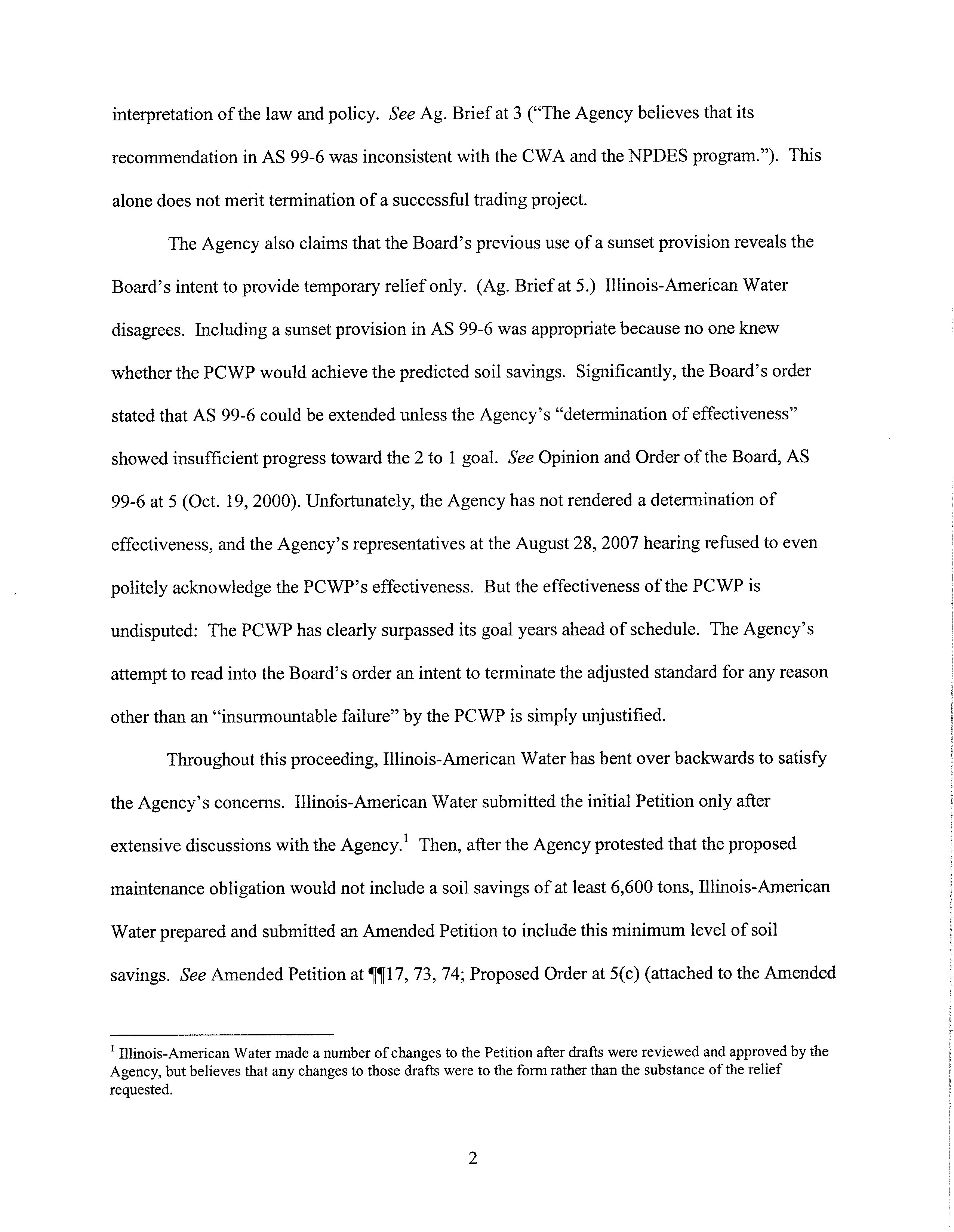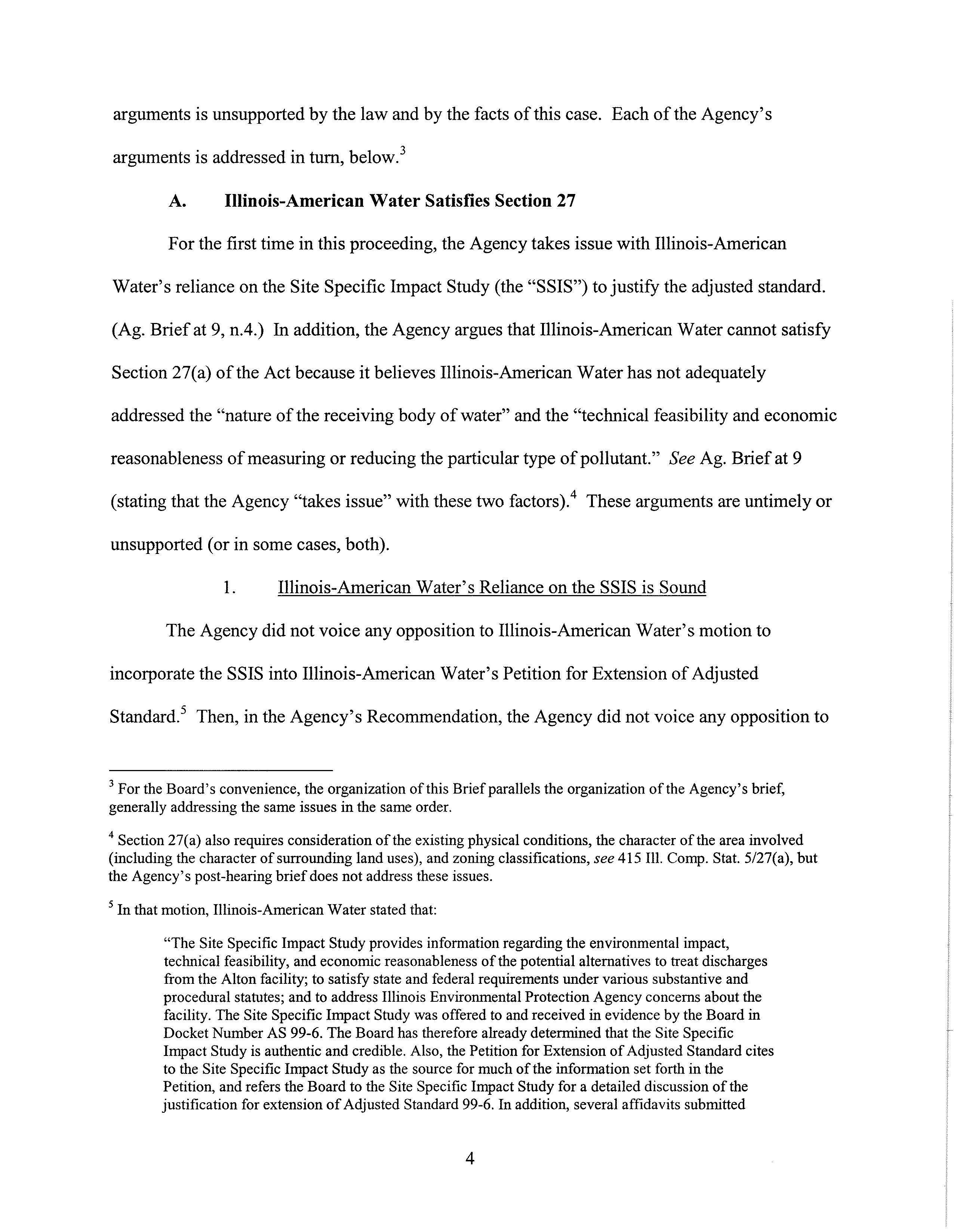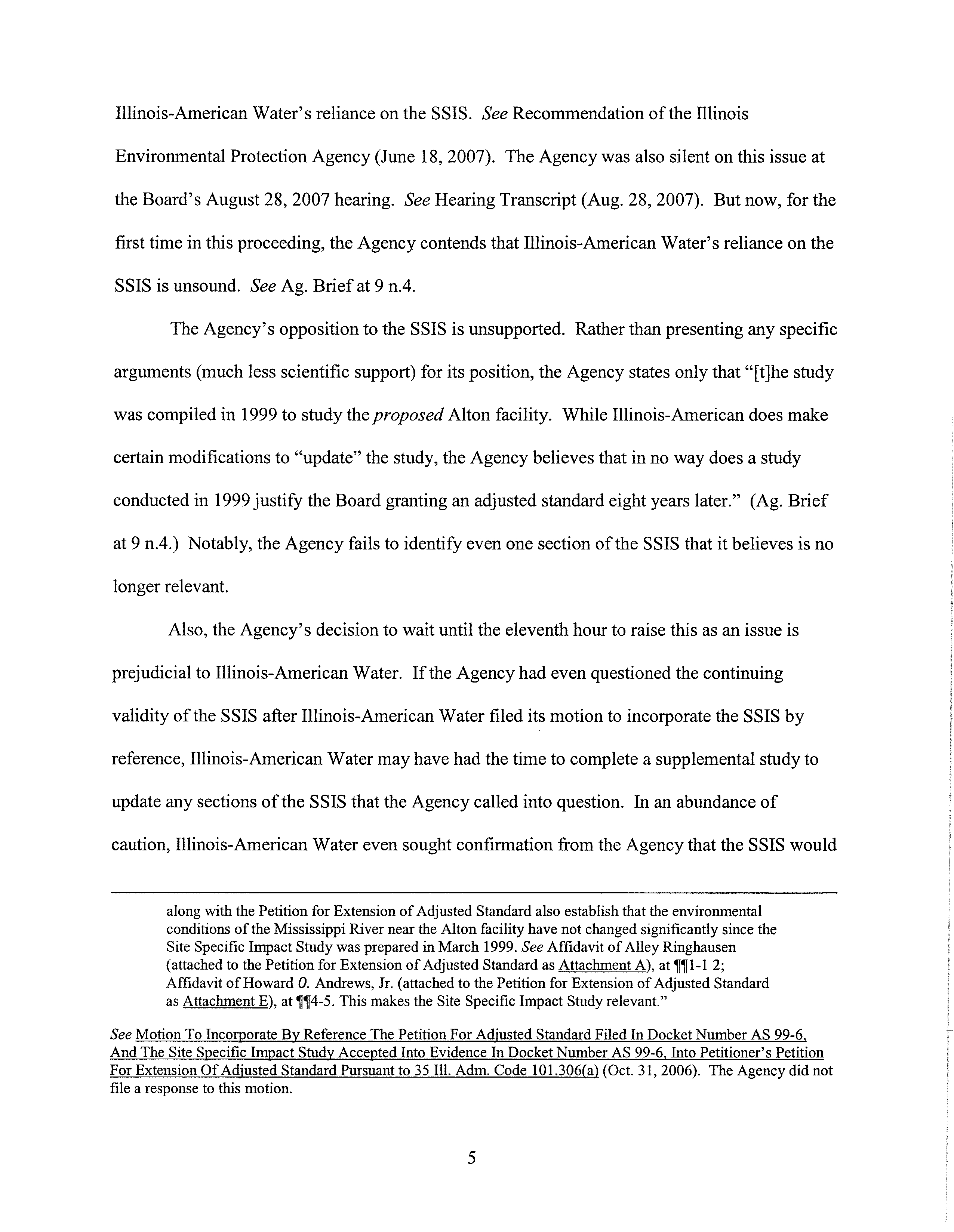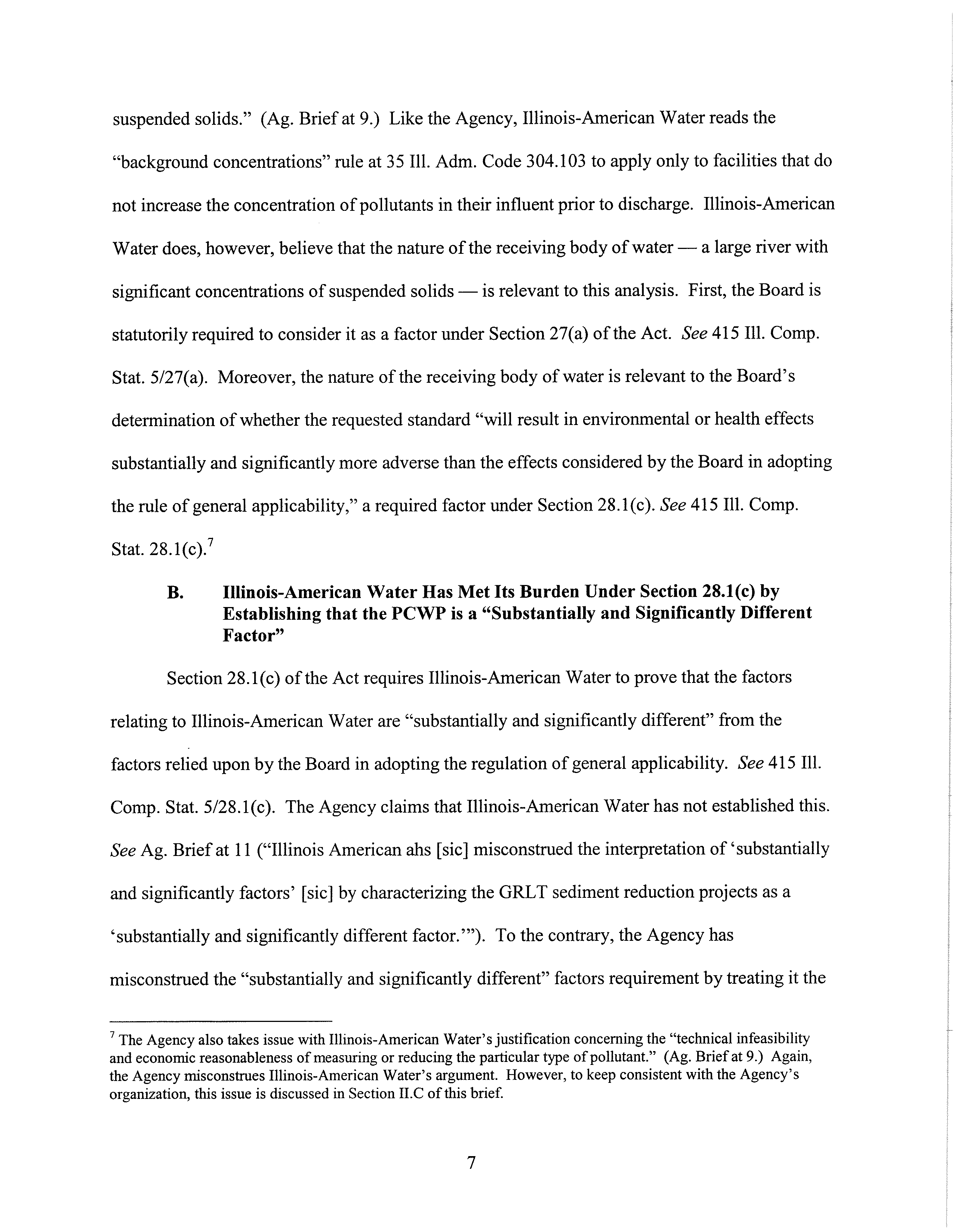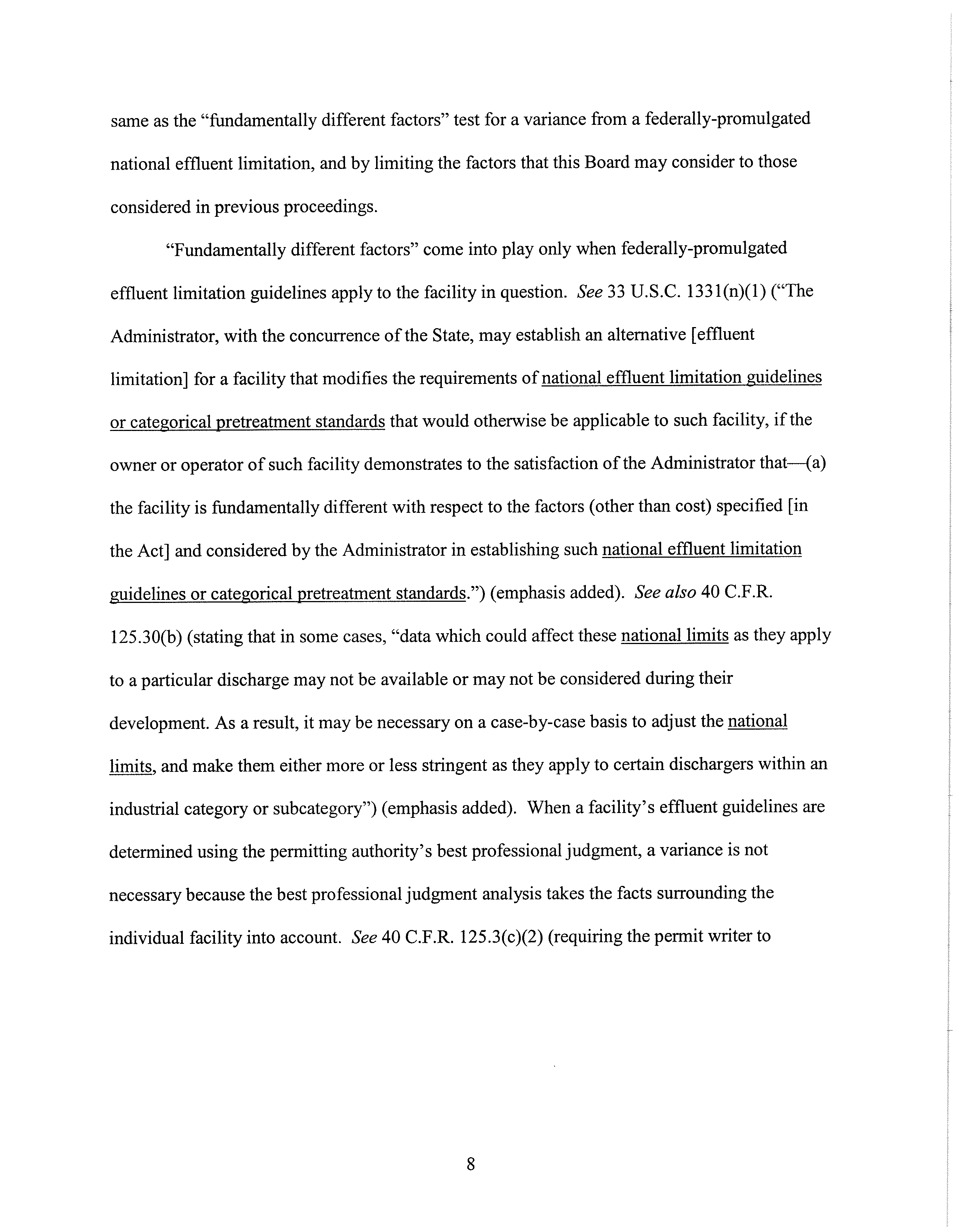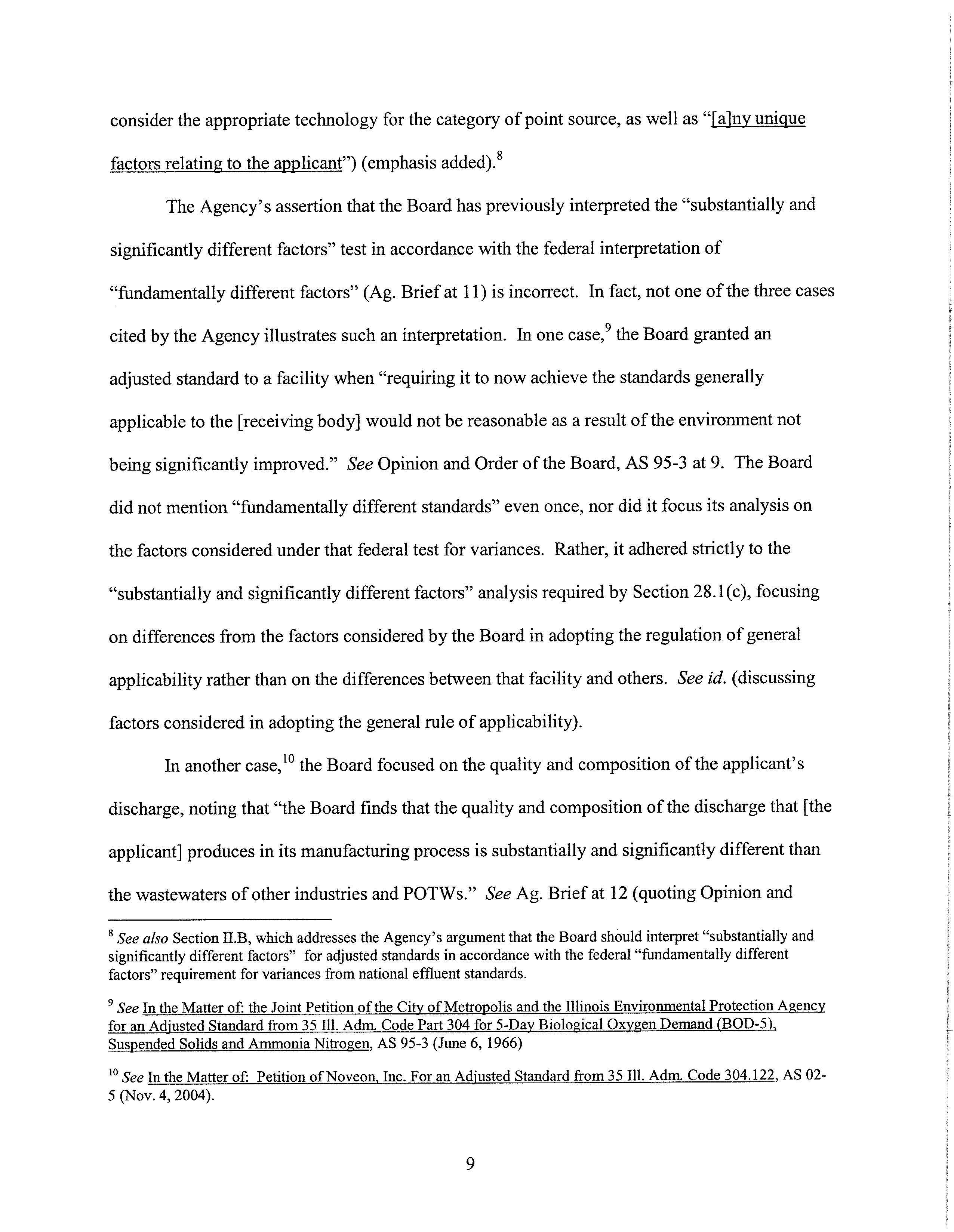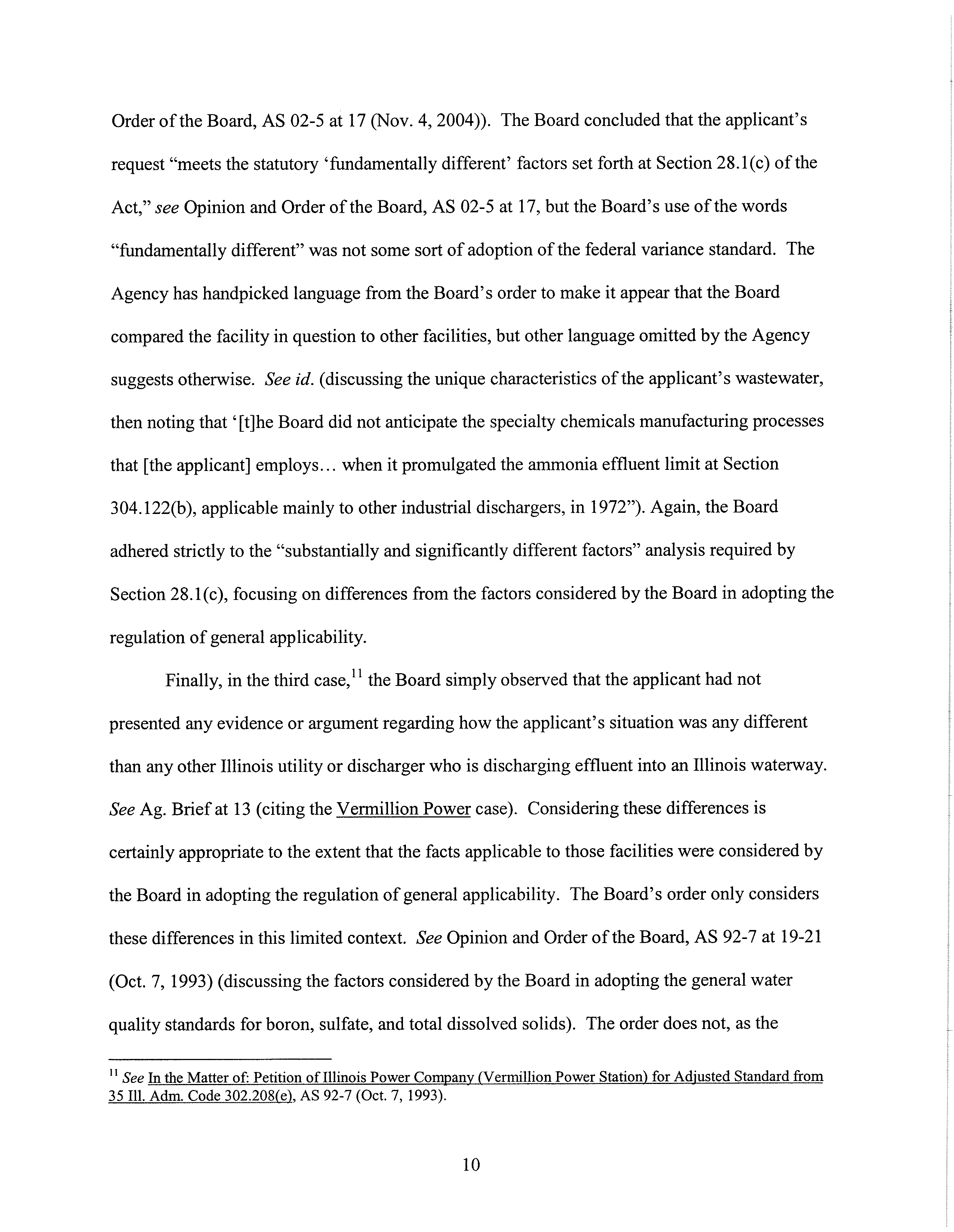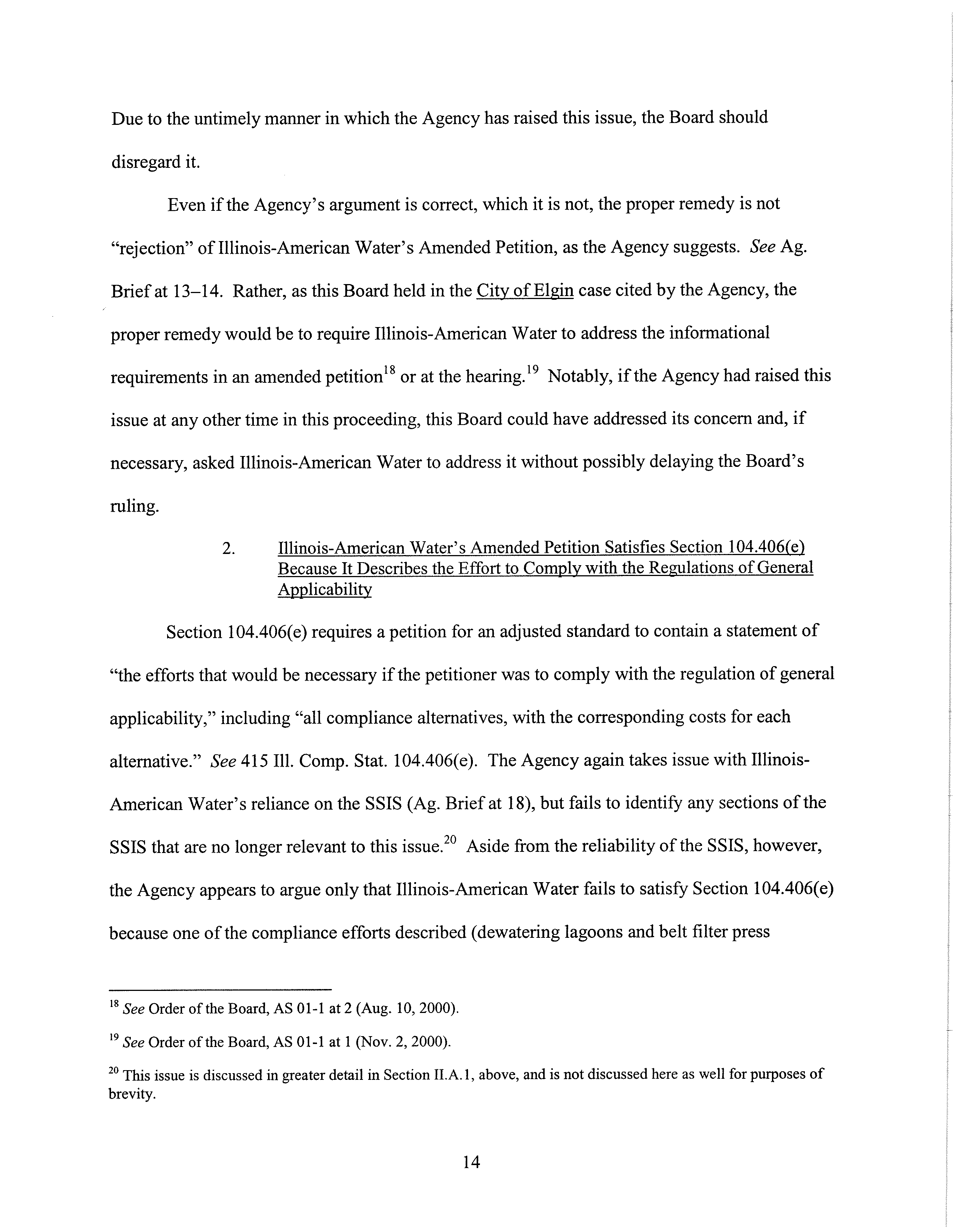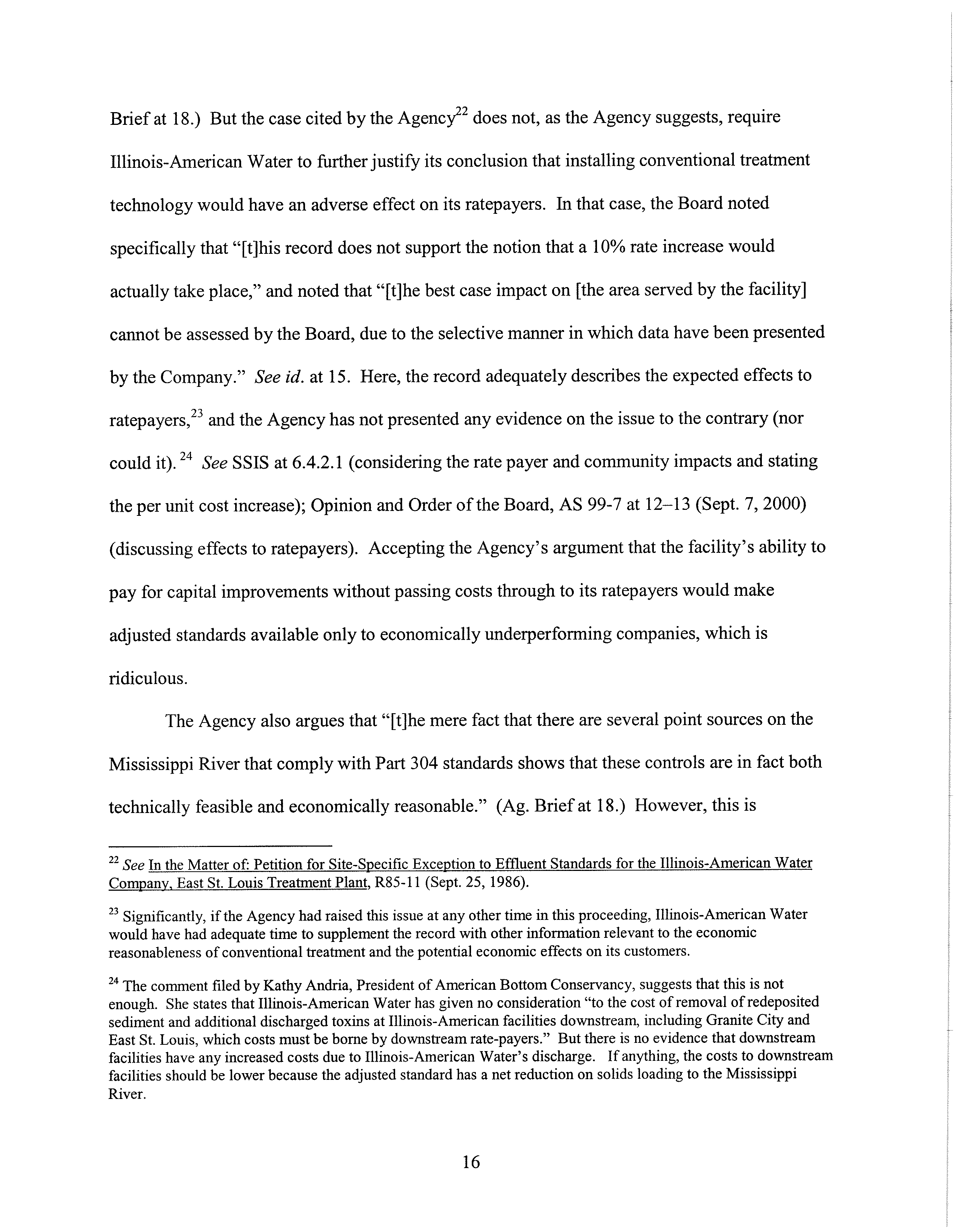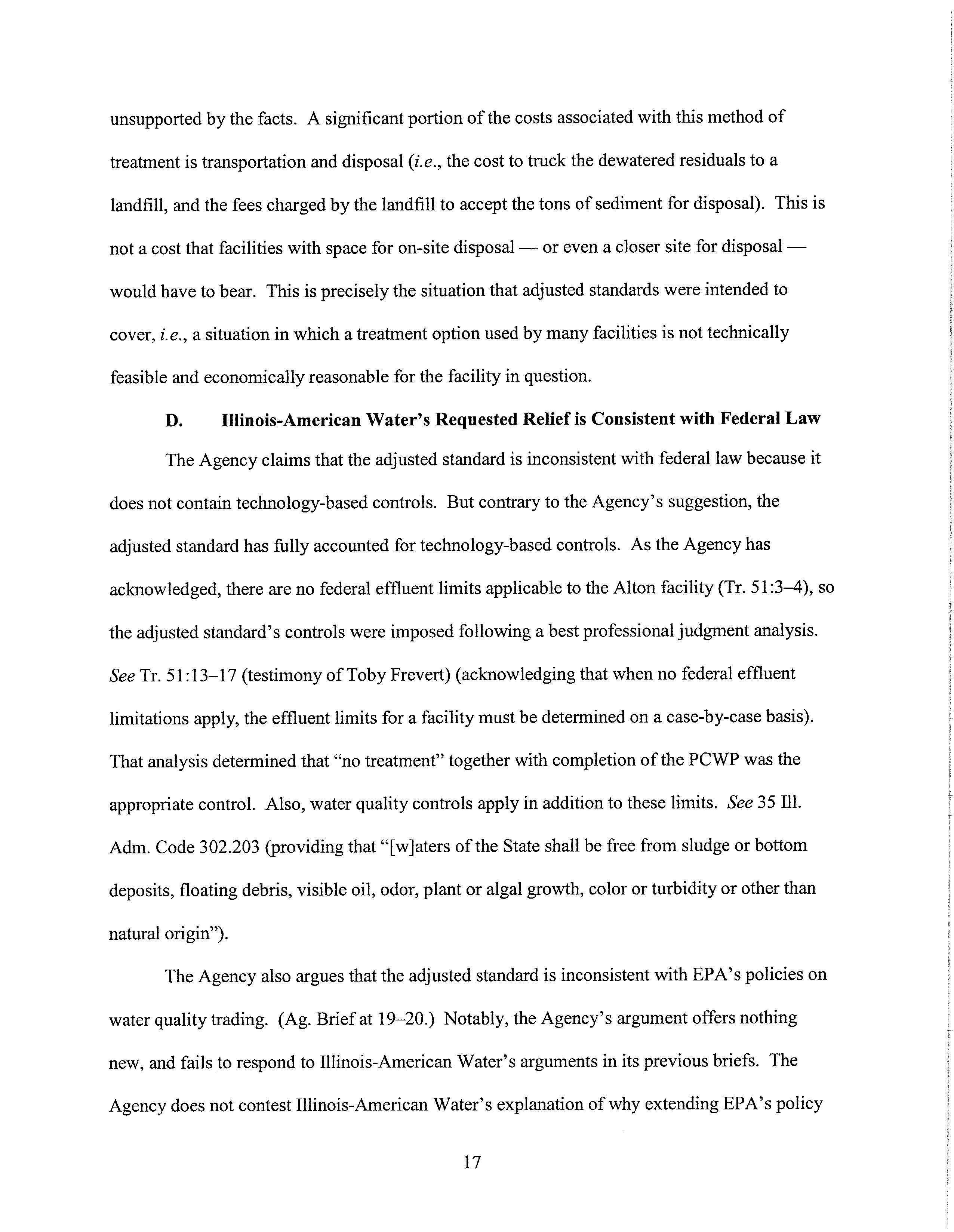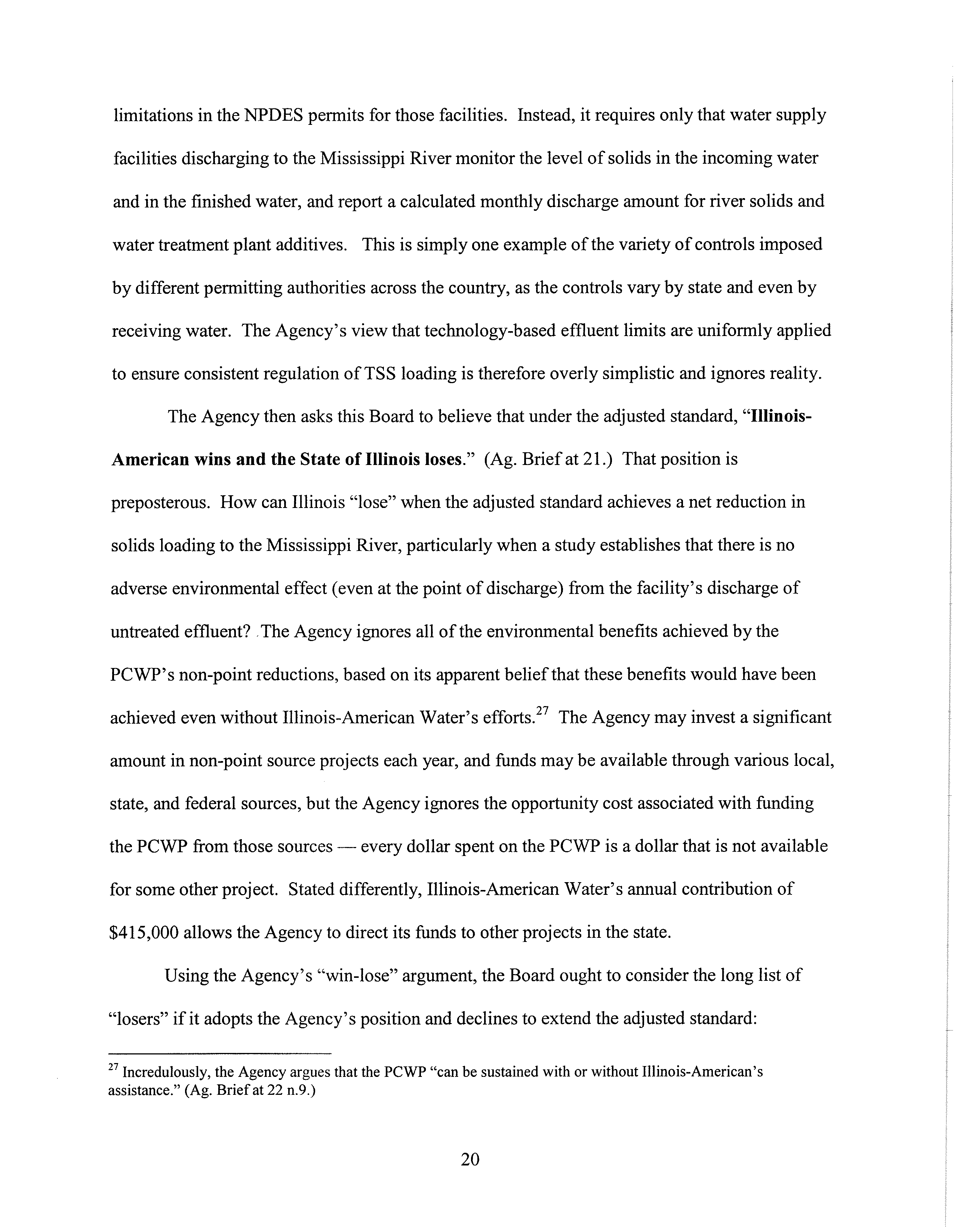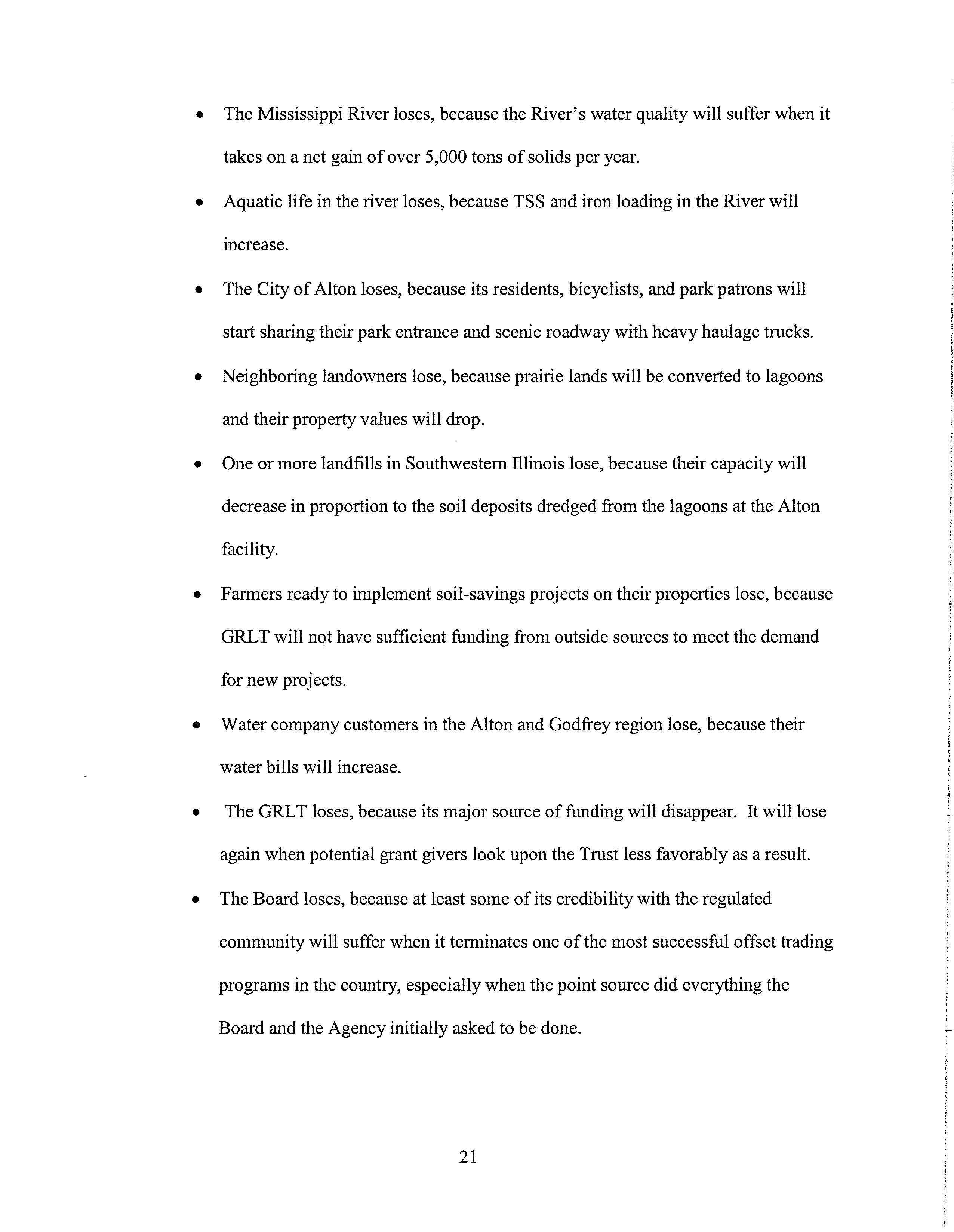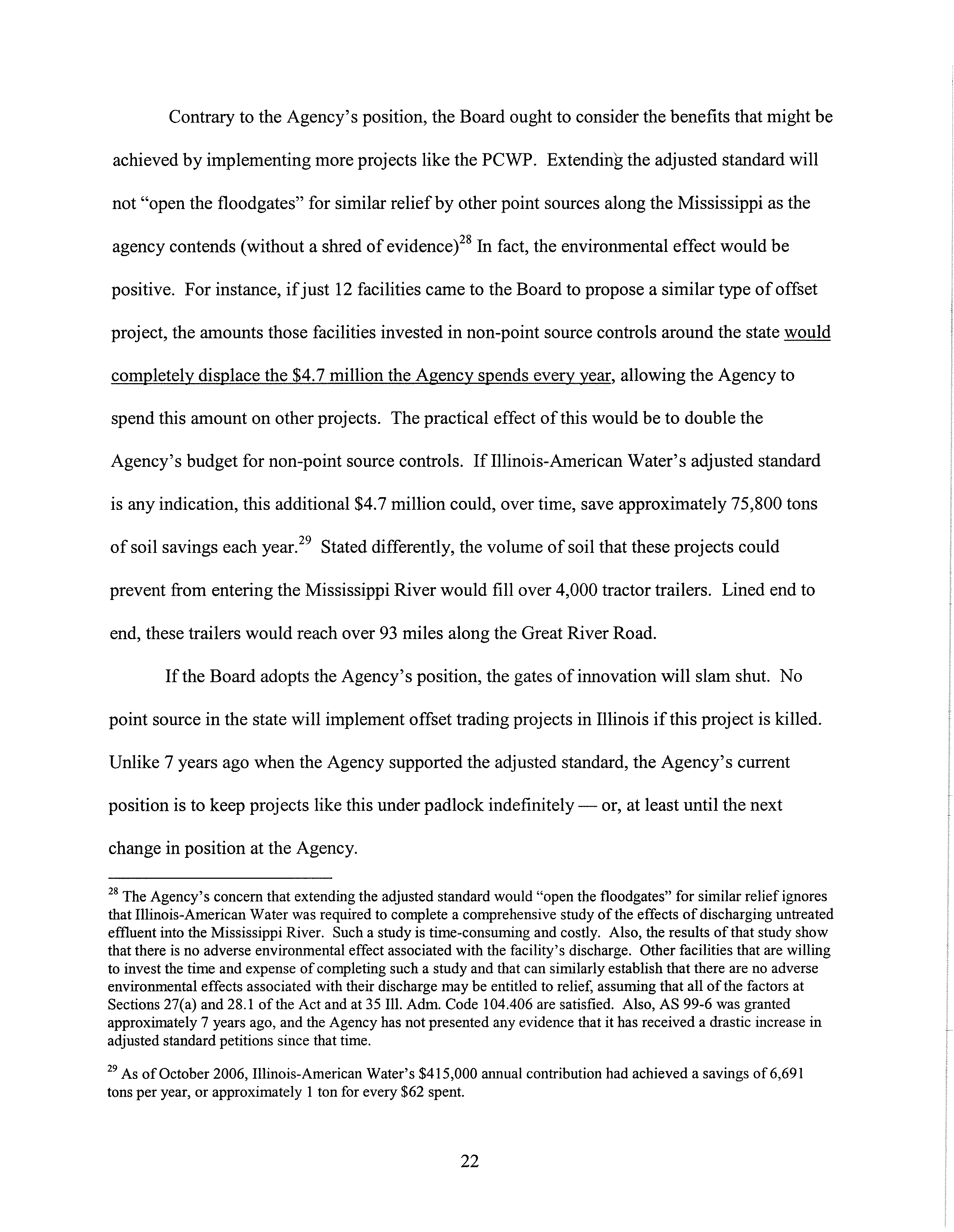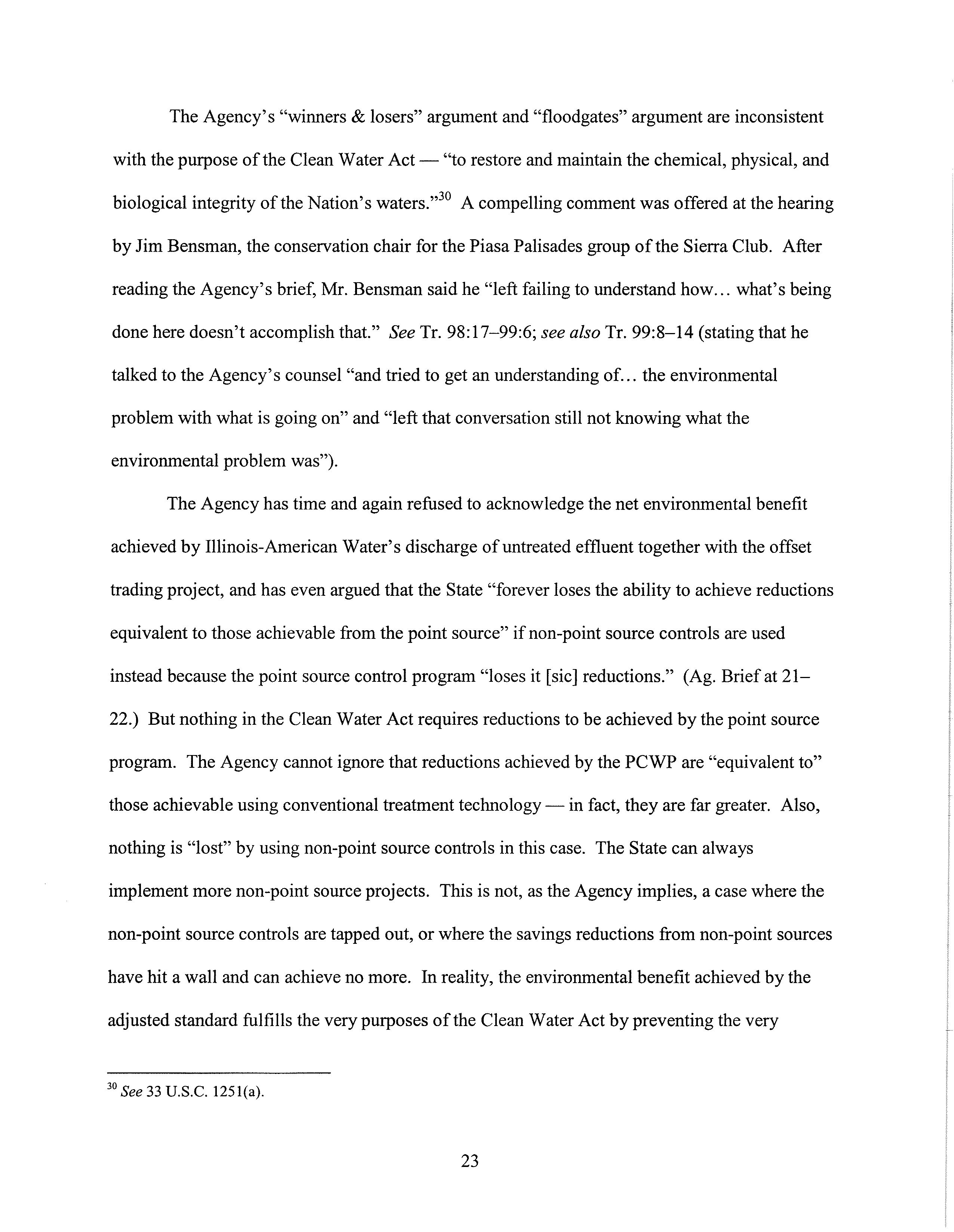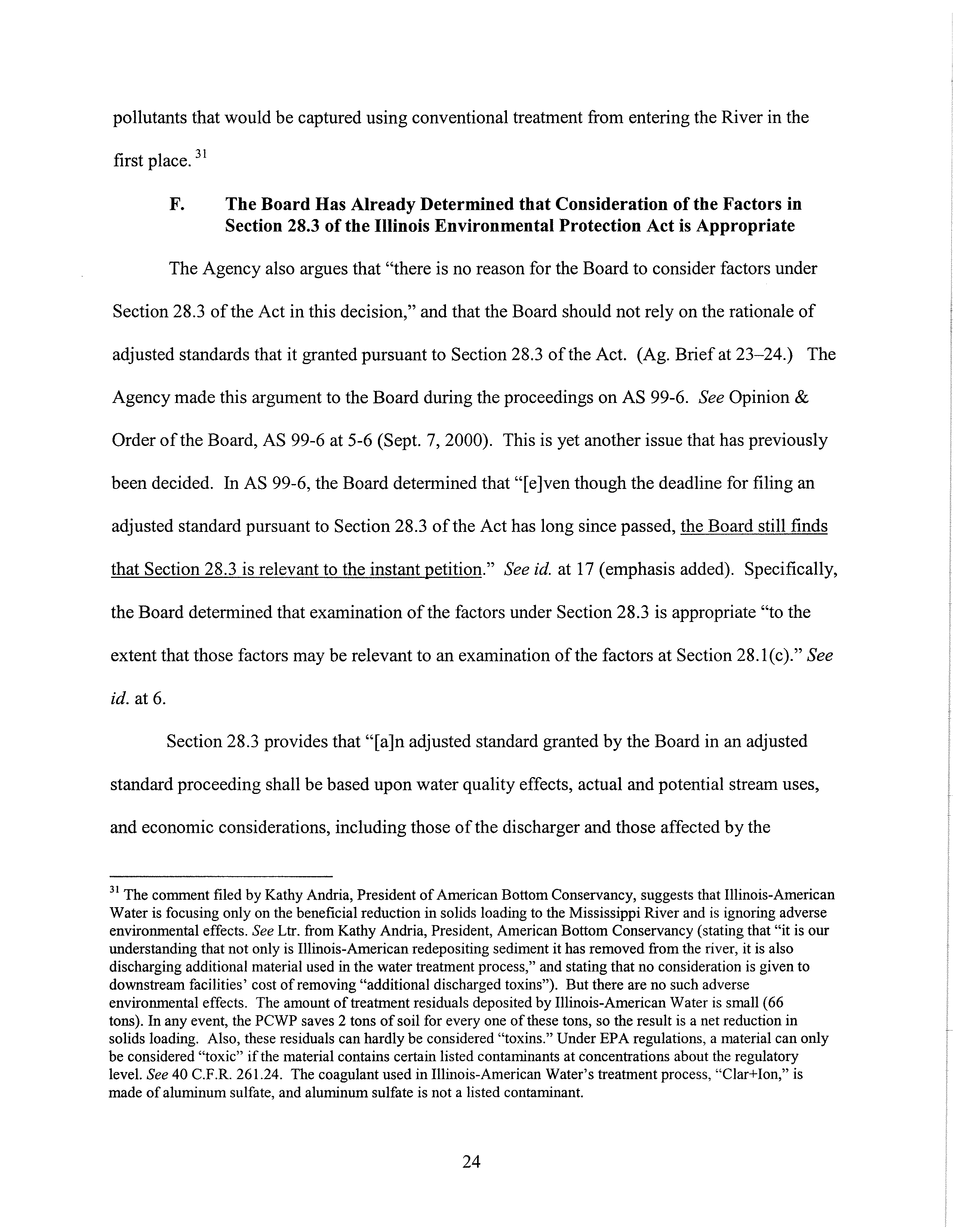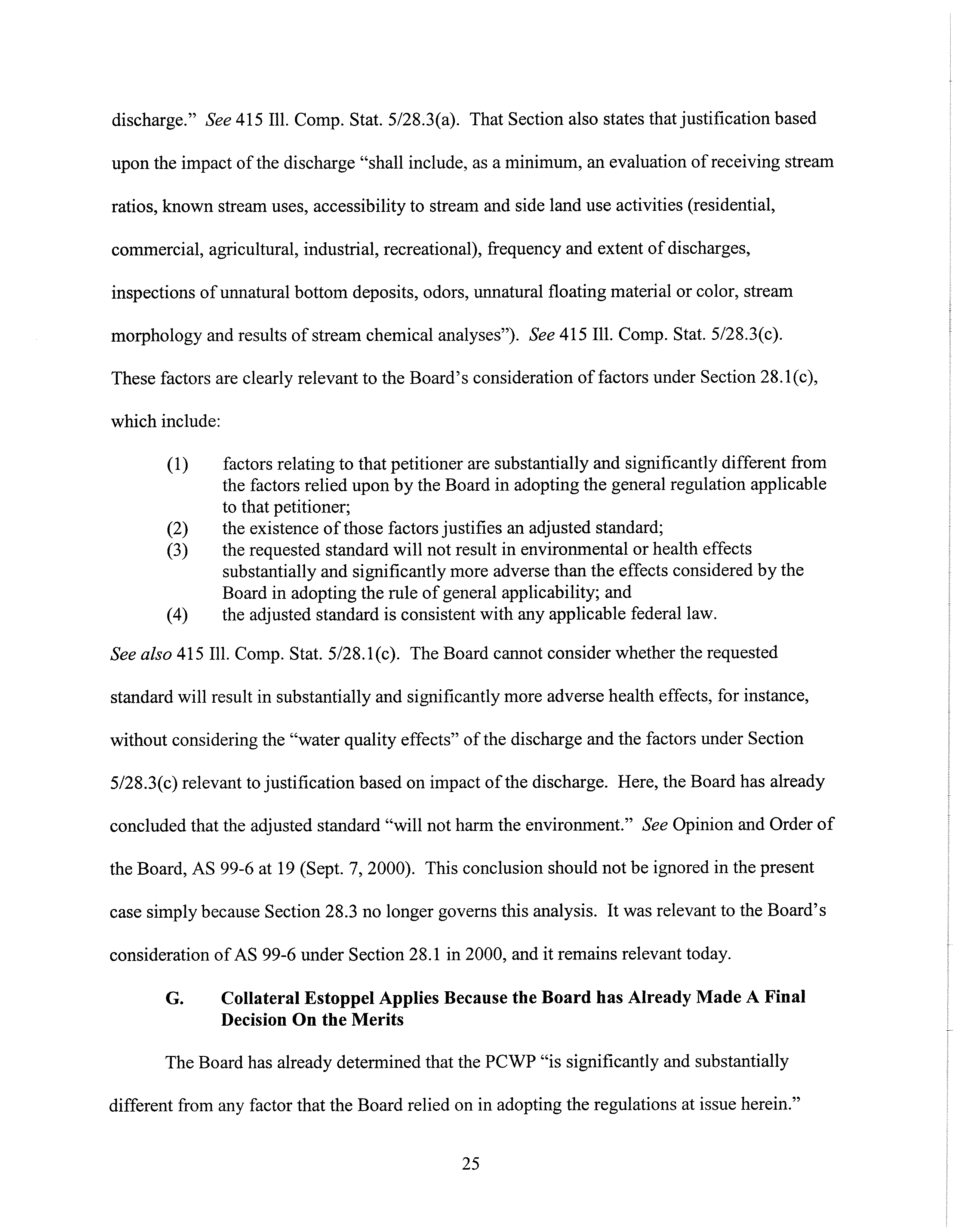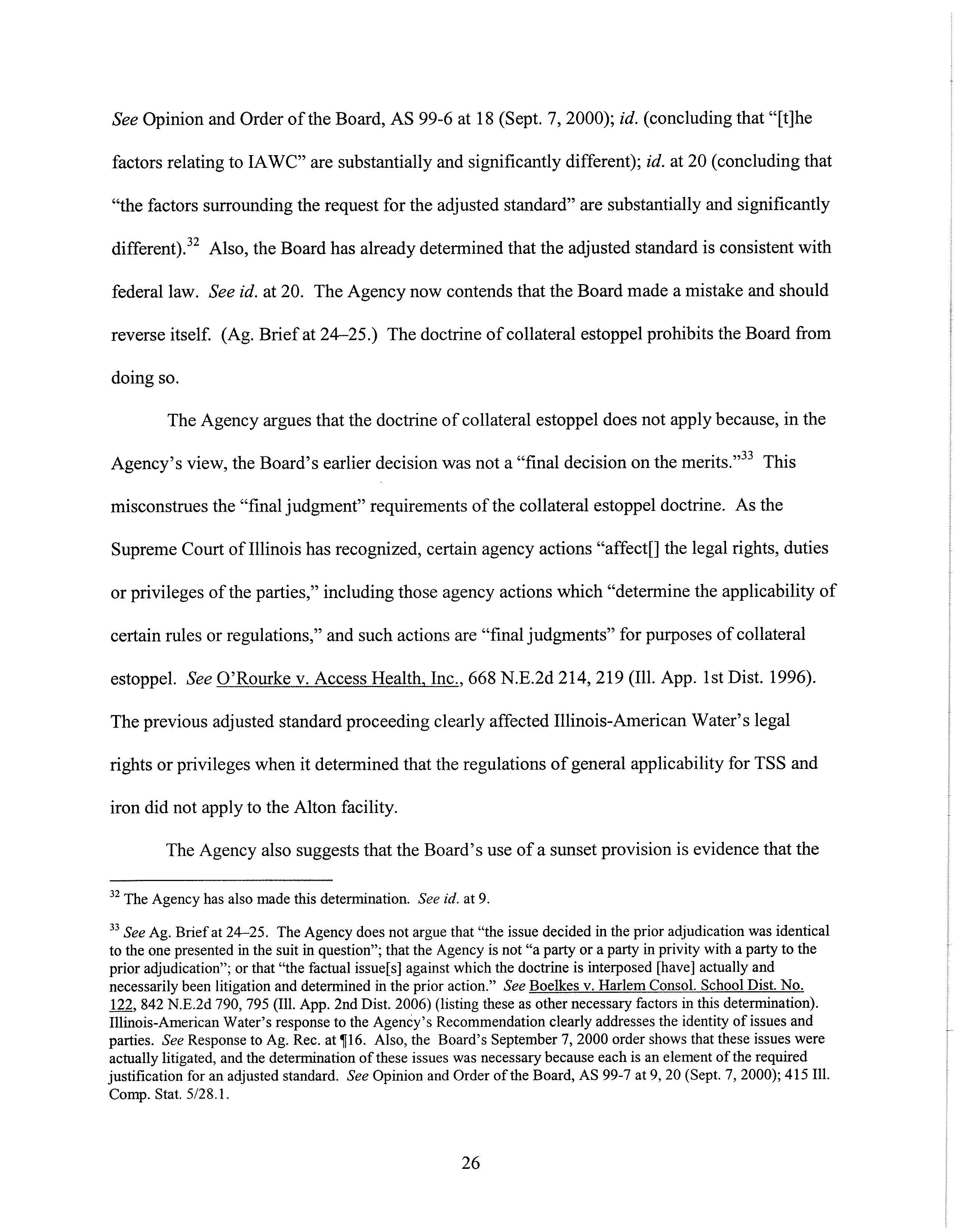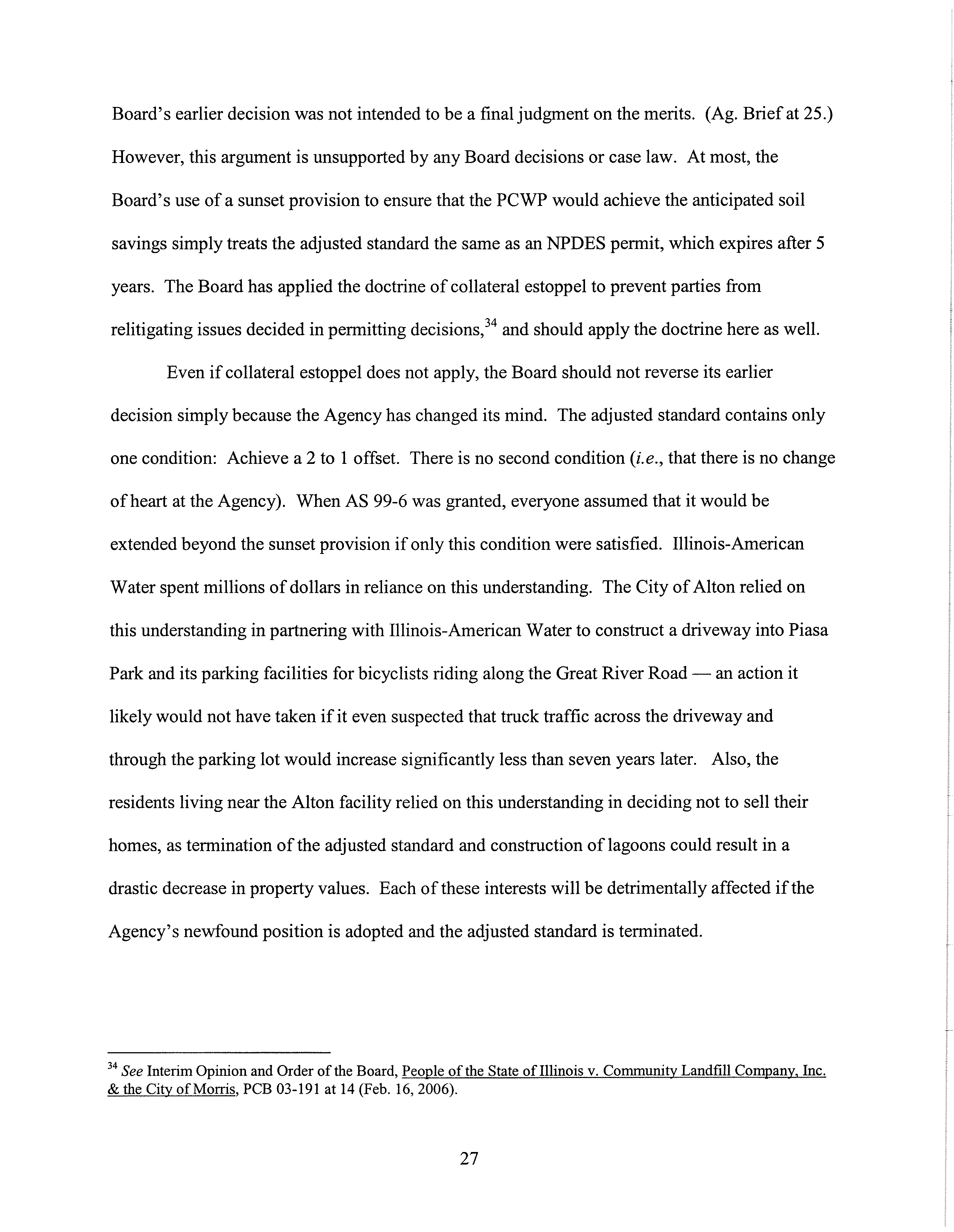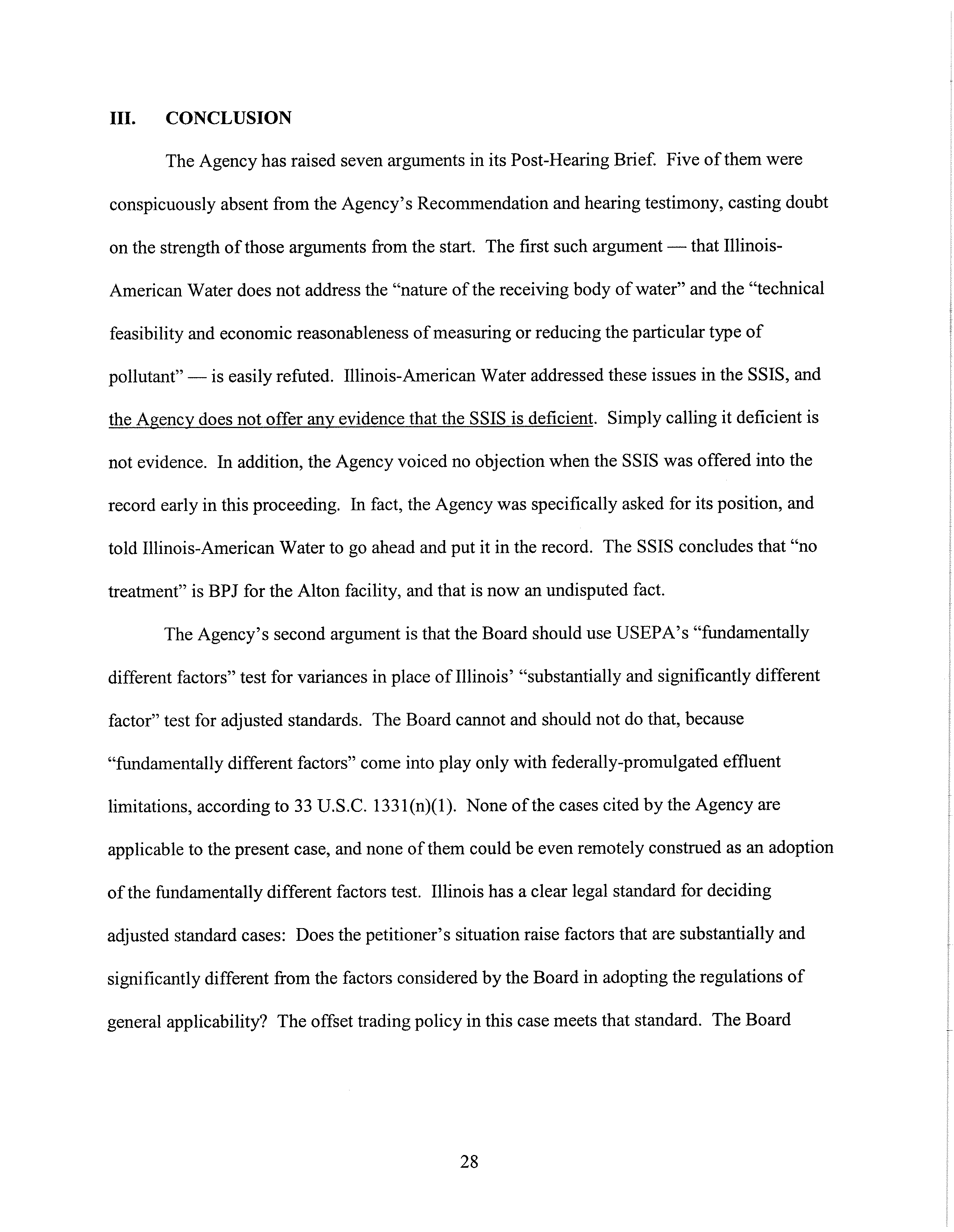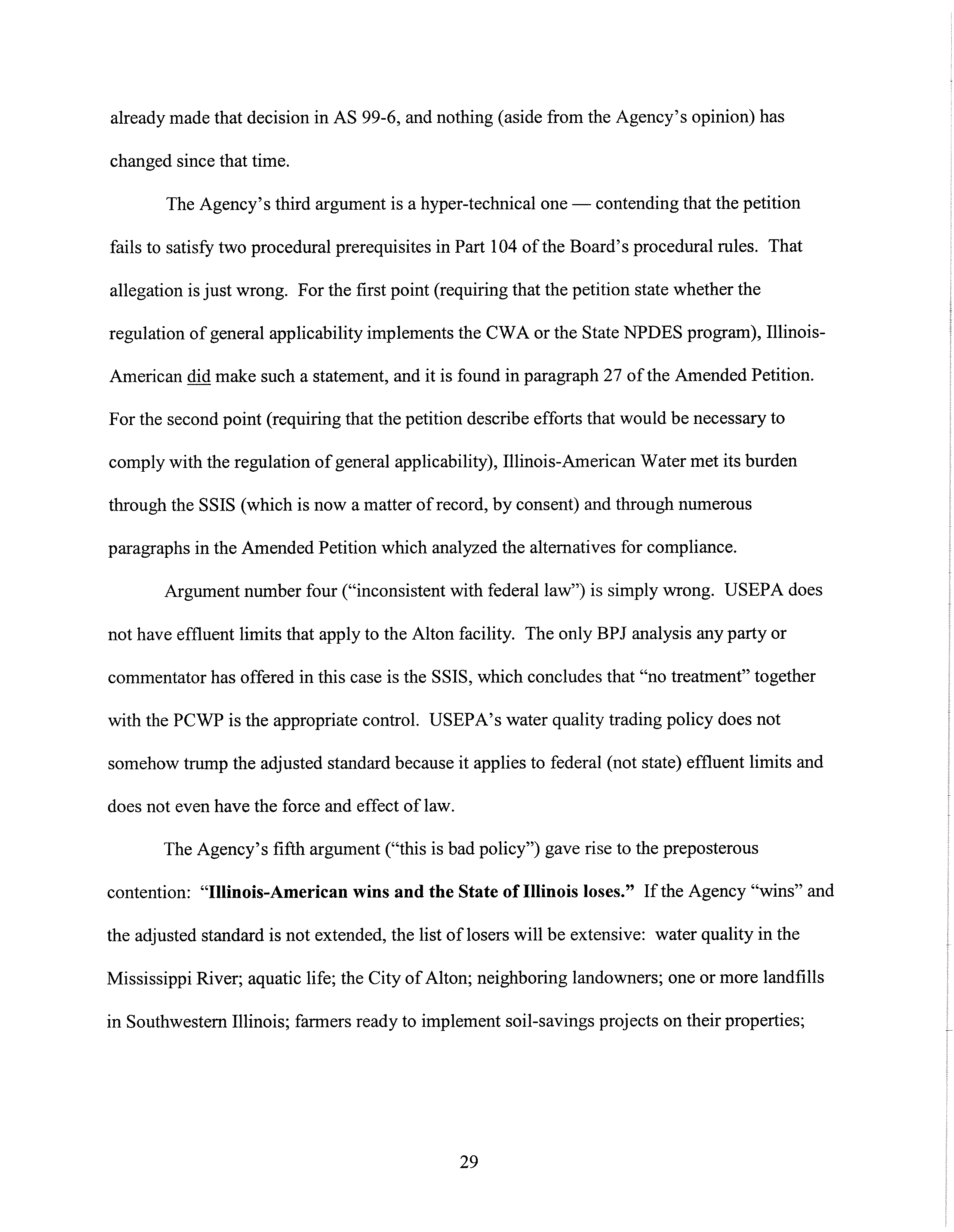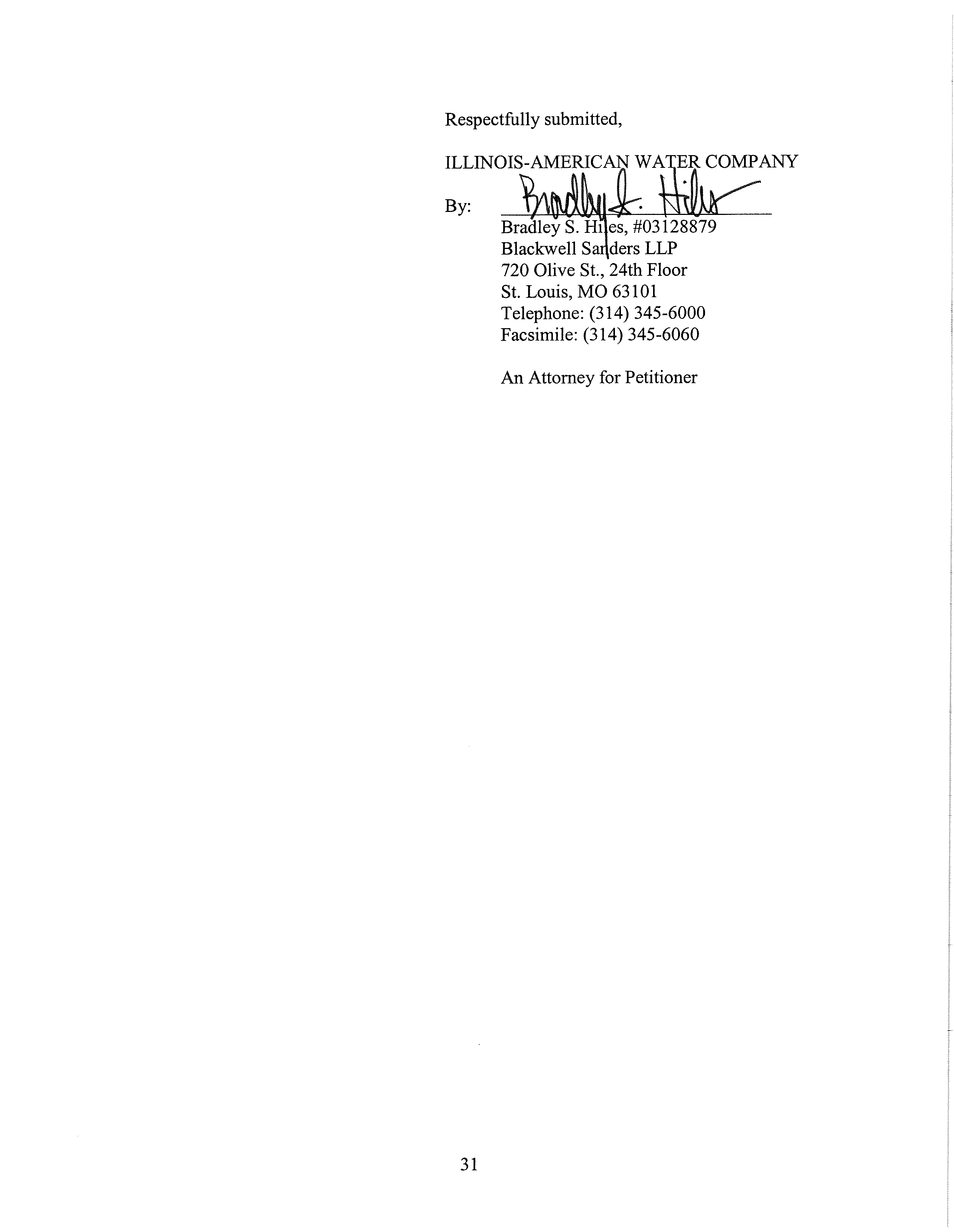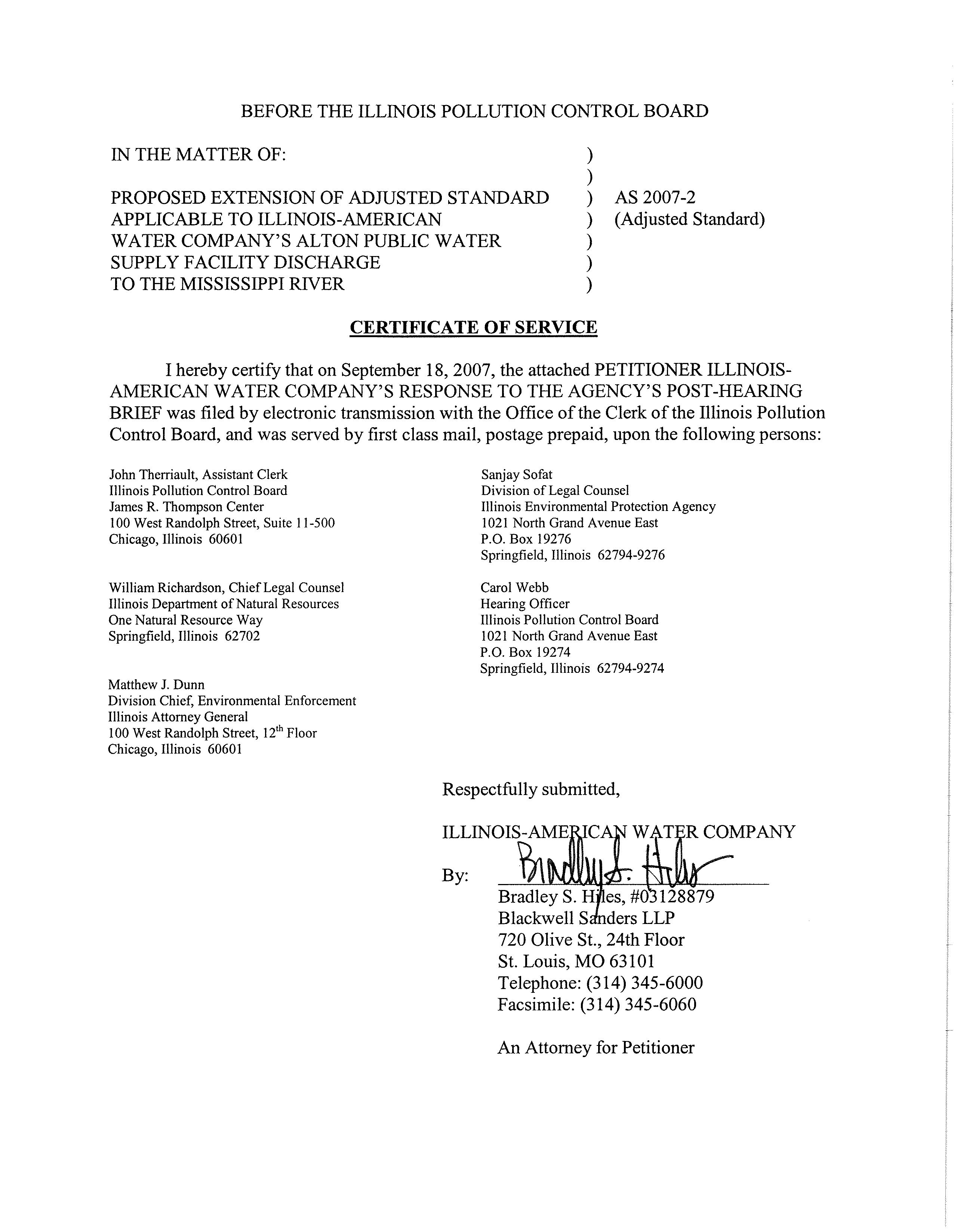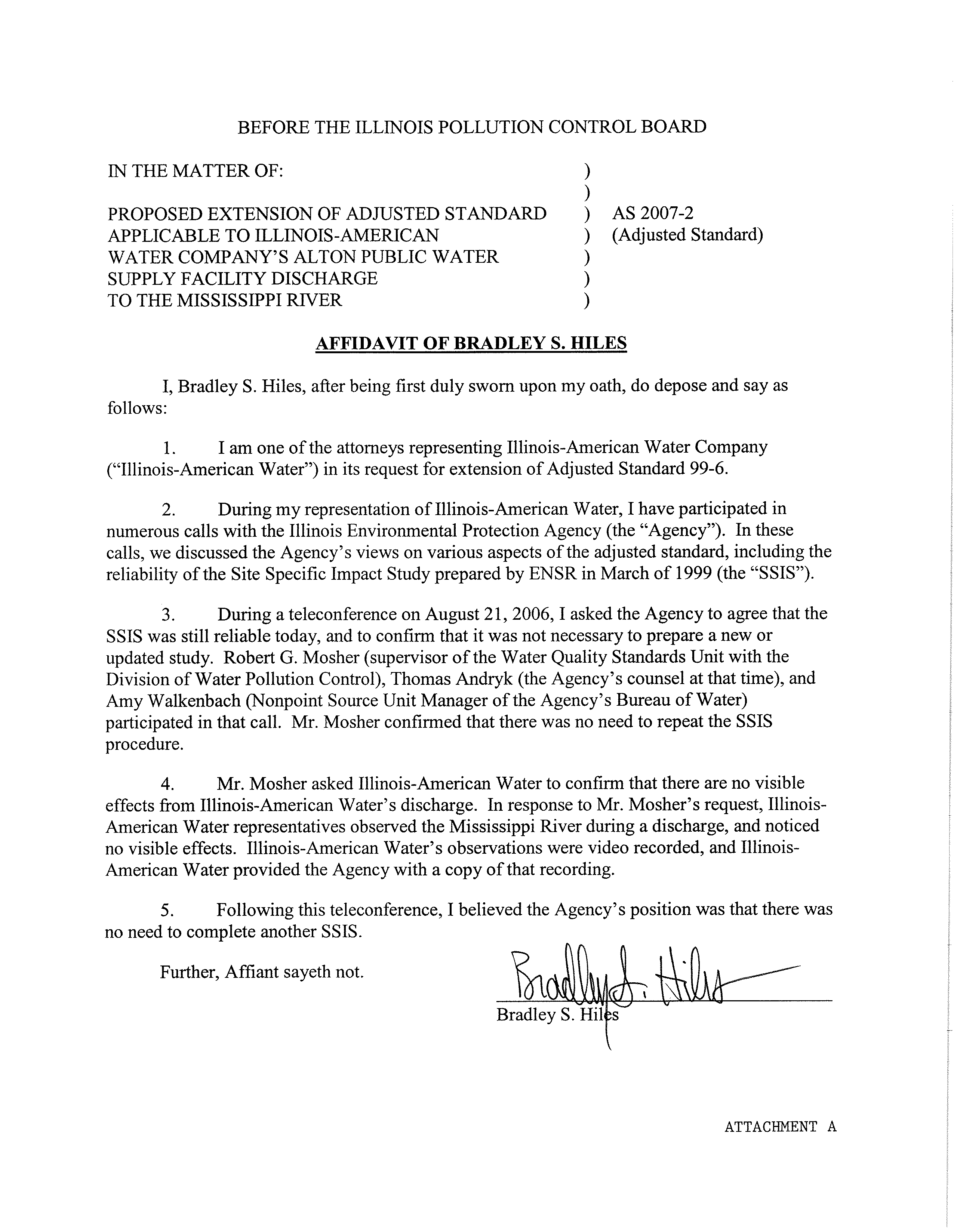BEFORE THE ILLINOIS POLLUTION CONTROL BOARD
IN THE MATTER OF:
)
)
PROPOSED EXTENSION OF ADJUSTED STANDARD )
APPLICABLE TO ILLINOIS-AMERICAN
)
WATER COMPANY'S ALTON PUBLIC
WATER
)
SUPPLY FACILITY DISCHARGE
)
TO THE MISSISSIPPI RIVER
)
NOTICE OF FILING
AS 2007-2
(Adjusted Standard)
John Therriault, Assistant Clerk
Illinois Pollution Control Board
James R. Thompson Center
100 West Randolph Street, Suite 11-500
Chicago, Illinois 60601
William Richardson,
Chief Legal Counsel
Illinois Department
of Natural Resources
One Natural Resource Way
Springfield, Illinois 62702
Matthew
1. Dunn
Division Chief, Environmental Enforcement
Illinois Attorney General
100 West Randolph Street,
12
th
Floor
Chicago, Illinois 60601
Sanjay Sofat
Division
of Legal Counsel
Illinois Environmental Protection Agency
1021 North Grand Avenue East
P.O. Box 19276
Springfield, Illinois 62794-9276
Carol Webb
Hearing Officer
Illinois Pollution Control Board
1021 North Grand Avenue East
P.O. Box 19274
Springfield, Illinois 62794-9274
PLEASE TAKE NOTICE that on September 18, 2007, the PETITIONER ILLINOIS-
AMERICAN WATER COMPANY'S RESPONSE
TO THE AGENCY'S POST-HEARING
BRIEF was filed with the Clerk of the Pollution Control Board. A copy is herewith served upon
you.
Respectfully submitted,
By:
Bradley S. Hi s, #03128879
Blackwell S ders LLP
720 Olive St., 24th Floor
St. Louis,
MO 63101
Telephone: (314) 345-6000
Facsimile: (314) 345-6060
An Attorney for Petitioner
Electronic Filing, Received, Clerk's Office, September 18, 2007
BEFORE THE ILLINOIS POLLUTION CONTROL BOARD
IN THE MATTER OF:
)
)
PROPOSED
EXTENSION OF ADJUSTED STANDARD
)
APPLICABLE
TO ILLINOIS-AMERICAN
)
WATER COMPANY'S ALTON PUBLIC WATER
)
SUPPLY
FACILITY DISCHARGE
)
TO THE MISSISSIPPI RIVER
)
AS 2007-2
(Adjusted Standard)
PETITIONER ILLINOIS-AMERICAN WATER COMPANY'S
RESPONSE TO THE AGENCY'S POST-HEARING BRIEF
Petitioner, Illinois-American Water Company ("Illinois-American Water"), by its
attorneys, Bradley S. Hiles and Alison M. Nelson, hereby submits its response to the Illinois
Environmental Protection
Agency's (the "Agency's) post-hearing brief.
I.
INTRODUCTION
Illinois-American Water has successfully fulfilled every requirement and condition of the
adjusted standard. It has achieved remarkable soil savings, far surpassing the 2 to 1 offset
required
by the Board's order in case AS 99-6. It has invested millions in sediment reduction
projects designed to offset the amount
of solids in its effluent. Also, it has earned the trust and
approval
of local communities, and has become a model for trading projects across the county.
Somehow, this is not enough for the Agency. Following a changing
of the guard in the
Agency'swater bureau, the Agency now claims that the Board should not extend the adjusted
standard because it
"has lost its justification." (Ag. Brief at 3.) But justification for this
particular adjusted standard has not been lost. Aside from the
Agency's position, the only thing
that has changed since the Board granted
AS 99-6 is that the PCWP is now a proven success.
The facts applicable to the facility's operation are the same, the law is the same, and the state and
federal policies for trading are the same. Rather, the Agency has simply changed its
1
Electronic Filing, Received, Clerk's Office, September 18, 2007
interpretation of the law and policy.
See
Ag. Brief at 3 ("The Agency believes that its
recommendation in AS 99-6 was inconsistent with the CWA and the NPDES program."). This
alone does not merit tennination
of a successful trading project.
The Agency also claims that the Board'sprevious use
of a sunset provision reveals the
Board'sintent to provide temporary
reliefonly. (Ag. Brief at 5.) Illinois-American Water
disagrees. Including a sunset provision in AS 99-6 was appropriate because no one knew
whether the
PCWP would achieve the predicted soil savings. Significantly, the Board'sorder
stated that AS 99-6 could be extended unless the Agency's"detennination
of effectiveness"
showed insufficient progress toward the 2 to 1 goal.
See
Opinion and Order ofthe Board, AS
99-6 at 5 (Oct. 19,2000). Unfortunately, the Agency has not rendered a detennination
of
effectiveness, and the Agency'srepresentatives at the August 28, 2007 hearing refused to even
politely acknowledge the
PCWP's effectiveness. But the effectiveness of the PCWP is
undisputed: The PCWP has clearly surpassed its goal years ahead
of schedule. The Agency's
attempt to read into the Board'sorder an intent to tenninate the adjusted standard for any reason
other than an "insunnountable failure"
by the PCWP is simply unjustified.
Throughout this proceeding, Illinois-American Water has bent over backwards to satisfy
the Agency's concerns. Illinois-American Water submitted the initial Petition only after
extensive discussions with the Agency.l Then, after the Agency protested that the proposed
maintenance obligation would not include a soil savings
of at least 6,600 tons, Illinois-American
Water prepared and submitted an Amended Petition to include this minimum level
of soil
savings.
See
Amended Petition at 1117, 73, 74; Proposed Order at 5(c) (attached to the Amended
I
Illinois-American Water made a number ofchanges to the Petition after drafts were reviewed and approved by the
Agency, but believes that any changes to those drafts were to the form rather than the substance of the relief
requested.
2
Electronic Filing, Received, Clerk's Office, September 18, 2007
Petition as Attachment F).2 But the Agency has responded each time with new concerns, new
questions, and
new justifications to support a new position.
The
Agency'spost-hearing brief is no different. It continues to state the Agency'sbasic
position - that the adjusted standard is inconsistent with federal law and that the
PCWP is not a
"substantially and significantly different factor." The Agency also offers some
new theories-
conspicuously absent from its Recommendation - in a last-ditch effort to support its position.
For instance, the Agency attempts to characterize Illinois-American Water'sjustification as a
"background concentrations" argument (Ag.
Brief at 9-10); argues that the term "substantially
and significantly different factors" must be interpreted
in accordance with the federal standard
for variances (Ag.
Brief at 11-13); claims that Illinois-American Water does not adequately
address whether the regulations
of general applicability were adopted to implement the
requirements
of the CWA or state NPDES programs (Ag. Brief 13-17); and alleges that the
Board should consider Illinois-American Water's ability to absorb costs
of compliance (Ag.
Brief at 18). Each of the Agency's new arguments fail, however, for the reasons discussed
below.
II.
ARGUMENT
The Agency's brief presents seven arguments in support of its recommendation that
Illinois-American Water'srequest for extension
of AS 99-6 should be denied, but each ofthese
2 In the Amended Petition, Illinois-American Water also deleted its request for extension of its adjusted standard
from the water quality standard for offensive discharges at 35 Ill. Adm. Code 302.203 because it determined that
such reliefwas no longer necessary.
See
Amended Petition at n.l. Also, the Agency indicated that it could not
support Illinois-American Water'srequest for extension
of the adjusted standard if relief from 35 Ill. Adm. Code
302.203 were included, because the Agency believed USEPA would require a site-specific rulemaking instead.
3
Electronic Filing, Received, Clerk's Office, September 18, 2007
arguments is unsupported by the law and by the facts of this case. Each of the Agency's
arguments is addressed in tum, below.
3
A.
Illinois-American Water Satisfies Section 27
For the first time in this proceeding, the Agency takes issue with Illinois-American
Water'sreliance on the Site Specific Impact Study (the "SSIS") to justify the adjusted standard.
(Ag. Brief at 9, n.4.) In addition, the Agency argues that Illinois-American Water cannot satisfy
Section 27(a) ofthe Act because it believes Illinois-American Water has not adequately
addressed the "nature
of the receiving body of water" and the "technical feasibility and economic
reasonableness of measuring or reducing the particular type ofpollutant."
See
Ag. Briefat 9
(stating that the Agency "takes issue" with these two factors).4 These arguments are untimely or
unsupported (or in some cases, both).
1.
Illinois-American Water'sReliance on the SSIS is Sound
The Agency did not voice any opposition to Illinois-American Water'smotion to
incorporate the SSIS into Illinois-American Water'sPetition for Extension of Adjusted
Standard.
5
Then, in the Agency'sRecommendation, the Agency did not voice any opposition to
3 For the Board'sconvenience, the organization ofthis Briefparallels the organization of the Agency's brief,
generally addressing the same issues in the same order.
4 Section 27(a) also requires consideration ofthe existing physical conditions, the character of the area involved
(including the character
of surrounding land uses), and zoning classifications,
see
415 Ill. Compo Stat. 5/27(a), but
the Agency'spost-hearing
brief does not address these issues.
5 In that motion, Illinois-American Water stated that:
"The Site Specific Impact Study provides information regarding the environmental impact,
technical feasibility, and economic reasonableness
of the potential alternatives to treat discharges
from the Alton facility; to satisfy state and federal requirements under various substantive and
procedural statutes; and to address Illinois Environmental Protection Agency concerns about the
facility. The Site Specific Impact Study was offered to and received in evidence by the Board in
Docket Number AS 99-6. The Board has therefore already determined that the Site Specific
Impact Study is authentic and credible. Also, the Petition for Extension
ofAdjusted Standard cites
to the Site Specific Impact Study as the source for much
ofthe information set forth in the
Petition, and refers the Board to the Site Specific Impact Study for a detailed discussion
of the
justification for extension
of Adjusted Standard 99-6. In addition, several affidavits submitted
4
Electronic Filing, Received, Clerk's Office, September 18, 2007
Illinois-American Water'sreliance on the SSIS.
See
Recommendation of the Illinois
Environmental Protection Agency (June 18, 2007). The Agency was also silent on this issue at
the Board'sAugust 28, 2007 hearing.
See
Hearing Transcript (Aug. 28, 2007). But now, for the
first time in this proceeding, the Agency contends that Illinois-American Water'sreliance on the
SSIS is unsound.
See
Ag. Brief at 9 n.4.
The Agency'sopposition to the SSIS is unsupported. Rather than presenting any specific
arguments (much less scientific support) for its position, the Agency states only that "[t]he study
was compiled in 1999 to study the
proposed
Alton facility. While Illinois-American does make
certain modifications to "update" the study, the Agency believes that in no way does a study
conducted in 1999 justify the Board granting an adjusted standard eight years later." (Ag.
Brief
at 9 n.4.) Notably, the Agency fails to identify even one section of the SSIS that it believes is no
longer relevant.
Also, the Agency'sdecision to wait until the eleventh hour to raise this as an issue is
prejudicial to Illinois-American Water.
If the Agency had even questioned the continuing
validity of the SSIS after Illinois-American Water filed its motion to incorporate the SSIS by
reference, Illinois-American Water may have had the time to complete a supplemental study to
update any sections ofthe SSIS that the Agency called into question.
In
an abundance of
caution, Illinois-American Water even sought confinnation from the Agency that the SSIS would
along with the Petition for Extension of Adjusted Standard also establish that the environmental
conditions
of the Mississippi River near the Alton facility have not changed significantly since the
Site Specific Impact Study was prepared in March 1999.
See
Affidavit of Alley Ringhausen
(attached to the Petition for Extension
of Adjusted Standard as Attachment A), at
~~l-l
2;
Affidavit
of Howard
O.
Andrews, Ir. (attached to the Petition for Extension of Adjusted Standard
as Attachment E), at
~~4-5.
This makes the Site Specific Impact Study relevant."
See
Motion To Incorporate By Reference The Petition For Adjusted Standard Filed In Docket Number AS 99-6,
And The Site Specific Impact Study Accepted Into Evidence In Docket Number
AS 99-6, Into Petitioner'sPetition
For Extension
Of Adjusted Standard Pursuant to 35 Ill. Adm. Code 101.306(a) (Oct. 31,2006). The Agency did not
file a response to this motion.
5
Electronic Filing, Received, Clerk's Office, September 18, 2007
be acceptable - and received that confinuation from Agency representatives in a telephone
conference on August 21,2006. Illinois-American Water'scounsel participated in that
conference with several Agency representatives, including Robert
G. Mosher (supervisor of the
Water Quality Standards Unit with the Division of Water Pollution Control), Thomas Andryk
(the Agency'scounsel at that time), and Amy Walkenbach (Nonpoint Source Unit Manager of
the Agency's Bureau of Water). Significantly, Mr. Mosher confinued that there would be no
need to repeat the SSIS procedure.
See
Affidavit of Bradley S. Hiles (attached to this response
as Attachment A). Mr. Mosher stated only that it would be helpful to the Agency to know that
there are no visible effects from Illinois-American Water'sdischarge. In response to Mr.
Mosher'sstatement, Illinois-American Water provided the Agency with evidence that there is no
visible "muddy streak" at the point
of discharge.
6
After supporting Illinois-American Water's
reliance on the SSIS, it is too late for the Agency to change its position simply because it realizes
that its other arguments are failing. The hearing has closed, and the evidence has already been
received. The Agency's argument should be ignored because it is wrong, and also because it is
untimely.
2.
The Agency Misinterprets Illinois-American Water'sArguments
Justifying Extension
ofthe Adjusted Standard
The Agency takes issue with Illinois-American Water'sjustification "concerning the
nature
ofthe receiving body of water." (Ag. Brief at 9.) However, the Agency misconstrues
Illinois-American Water's argument. Illinois-American Water does not, as the Agency suggests,
argue that the "existing background concentration warrants an adjusted standard from total
6 Illinois-American Water provided the Agency with a DVD titled "Alton Discharge Video, August 28,2006 10:00
AM, Filter
#1 after 90 hours Service, River Turbidity - 20 NTU, L&D Pool Elevation - 419.3 ft, Ryan Schuler-
Paul Keck," which shows visual observations from the shore of a discharge under these conditions. No muddy
plume is visible. The Agency did not request additional proof.
6
Electronic Filing, Received, Clerk's Office, September 18, 2007
suspended solids." (Ag. Brief at 9.) Like the Agency, Illinois-American Water reads the
"background concentrations" rule at 35 Ill. Adm. Code 304.103 to apply only to facilities that do
not increase the concentration
ofpollutants in their influent prior to discharge. Illinois-American
Water does, however, believe that the nature of the receiving body ofwater - a large river with
significant concentrations of suspended solids - is relevant to this analysis. First, the Board is
statutorily required to consider it as a factor under Section 27(a) ofthe Act.
See
415 Ill. Compo
Stat. 5/27(a). Moreover, the nature of the receiving body of water is relevant to the Board's
determination of whether the requested standard "will result in environmental or health effects
substantially and significantly more adverse than the effects considered by the Board in adopting
the rule
of general applicability," a required factor under Section 28 .1 (c).
See
415 Ill. Compo
Stat. 28.1(c).7
B.
Illinois-American Water Has Met Its Burden Under Section 28.1(c) by
Establishing that the PCWP is a "Substantially and Significantly Different
Factor"
Section 28.1(c) of the Act requires Illinois-American Water to prove that the factors
relating to Illinois-American Water are "substantially and significantly different" from the
factors relied upon by the Board in adopting the regulation of general applicability.
See
415 Ill.
Compo Stat. 5/28.1(c). The Agency claims that Illinois-American Water has not established this.
See
Ag. Brief at 11 ("Illinois American ahs [sic] misconstrued the interpretation of'substantially
and significantly factors' [sic] by characterizing the GRLT sediment reduction projects as a
'substantiallyand significantly different factor."'). To the contrary, the Agency has
misconstrued the "substantially and significantly different" factors requirement by treating it the
7 The Agency also takes issue with Illinois-American Water'sjustification concerning the "technical infeasibility
and economic reasonableness
of measuring or reducing the particular type ofpollutant." (Ag. Briefat 9.) Again,
the Agency misconstrues Illinois-American Water's argument. However, to keep consistent with the Agency's
organization, this issue is discussed in Section II.C of this brief.
7
Electronic Filing, Received, Clerk's Office, September 18, 2007
same as the "fundamentally different factors" test for a variance from a federally-promulgated
national effluent limitation, and by limiting the factors that this Board may consider to those
considered in previous proceedings.
"Fundamentally different factors" come into play only when federally-promulgated
effluent limitation guidelines apply to the facility
in question.
See
33 U.S.C. 1331 (n)(1) ("The
Administrator, with the concurrence of the State, may establish an alternative [effluent
limitation] for a facility that modifies the requirements ofnational effluent limitation guidelines
or categorical pretreatment standards that would otherwise be applicable to such facility, if the
owner or operator
of such facility demonstrates to the satisfaction of the Administrator that-(a)
the facility is fundamentally different with respect to the factors (other than cost) specified [in
the Act] and considered by the Administrator in establishing such national effluent limitation
guidelines or categorical pretreatment standards.") (emphasis added).
See also
40 C.F.R.
125.30(b) (stating that in some cases, "data which could affect these national limits as they apply
to a particular discharge may not be available or
may not be considered during their
development. As a result, it may be necessary on a case-by-case basis to adjust the national
limits, and make them either more or less stringent as they apply to certain dischargers within an
industrial category or subcategory") (emphasis added). When a facility's effluent guidelines are
determined using the permitting authority'sbest professional judgment, a variance is not
necessary because the best professional judgment analysis takes the facts surrounding the
individual facility into account.
See
40 C.F.R. 125.3(c)(2) (requiring the permit writer to
8
Electronic Filing, Received, Clerk's Office, September 18, 2007
consider the appropriate technology for the category of point source, as well as "[a]ny unique
factors relating to the applicant") (emphasis added).
8
The Agency'sassertion that the Board has previously interpreted the "substantially and
significantly different factors" test in accordance with the federal interpretation
of
"fundamentally different factors" (Ag. Briefat 11) is incorrect. In fact, not one of the three cases
cited
by the Agency illustrates such an interpretation.
In
one case,9 the Board granted an
adjusted standard to a facility when "requiring it to now achieve the standards generally
applicable to the [receiving body] would not be reasonable as a result ofthe environment not
being significantly improved."
See
Opinion and Order ofthe Board, AS 95-3 at 9. The Board
did not mention "fundamentally different standards" even once, nor did it focus its analysis on
the factors considered under that federal test for variances. Rather, it adhered strictly to the
"substantially and significantly different factors" analysis required by Section 28.1 (c), focusing
on differences from the factors considered
by the Board in adopting the regulation of general
applicability rather than on the differences between that facility and others.
See id.
(discussing
factors considered in adopting the general rule of applicability).
In
another case, 10 the Board focused on the quality and composition of the applicant's
discharge, noting that "the Board finds that the quality and composition of the discharge that [the
applicant] produces in its manufacturing process is substantially and significantly different than
the wastewaters of other industries and POTWs."
See
Ag. Brief at 12 (quoting Opinion and
8
See also
Section II.B, which addresses the Agency's argument that the Board should interpret "substantially and
significantly different factors" for adjusted standards in accordance with the federal "fundamentally different
factors" requirement for variances from national effluent standards.
9 See
In the Matter of: the Joint Petition of the City ofMetropolis and the Illinois Environmental Protection Agency
for an Adjusted Standard from 35 Ill. Adm. Code Part 304 for 5-Day Biological Oxygen Demand (BOD-5),
Suspended Solids and Ammonia Nitrogen, AS 95-3 (June 6, 1966)
10
See
In the Matter of: Petition ofNoveon, Inc. For an Adjusted Standard from 35 Ill. Adm. Code 304.122, AS 02-
5 (Nov. 4, 2004).
9
Electronic Filing, Received, Clerk's Office, September 18, 2007
Order of the Board, AS 02-5 at 17 (Nov. 4, 2004)). The Board concluded that the applicant's
request "meets the statutory 'fundamentallydifferent' factors set forth at Section 28.1(c)
ofthe
Act,"
see
Opinion and Order ofthe Board, AS 02-5 at 17, but the Board'suse ofthe words
"fundamentally different" was not some sort
of adoption of the federal variance standard. The
Agency has handpicked language from the Board'sorder to make it appear that the Board
compared the facility in question to other facilities, but other language omitted by the Agency
suggests otherwise.
See id.
(discussing the unique characteristics of the applicant'swastewater,
then noting that '[t]heBoard did not anticipate the specialty chemicals manufacturing processes
that [the applicant] employs... when it promulgated the ammonia effluent limit at Section
304. 122(b), applicable mainly to other industrial dischargers, in 1972"). Again, the Board
adhered strictly to the "substantially and significantly different factors" analysis required by
Section 28.1 (c), focusing on differences from the factors considered
by the Board in adopting the
regulation
of general applicability.
Finally, in the third case,
11 the Board simply observed that the applicant had not
presented any evidence
or argument regarding how the applicant'ssituation was any different
than any other Illinois utility or discharger who is discharging effluent into an Illinois waterway.
See
Ag. Brief at 13 (citing the Vermillion Power case). Considering these differences is
certainly appropriate to the extent that the facts applicable to those facilities were considered by
the Board in adopting the regulation of general applicability. The Board'sorder only considers
these differences in this limited context.
See
Opinion and Order ofthe Board, AS 92-7 at 19-21
(Oct. 7, 1993) (discussing the factors considered by the Board in adopting the general water
quality standards for boron, sulfate, and total dissolved solids). The order does not, as the
11
See
In the Matter of: Petition of Illinois Power Company (Vermillion Power Station) for Adjusted Standard from
35
Ill.
Adm. Code 302.208(e), AS 92-7 (Oct. 7,1993).
10
Electronic Filing, Received, Clerk's Office, September 18, 2007
Agency suggests, require Illinois-American Water to draw comparisons with other water supply
facilities. Also, the order does not indicate that "substantially and significantly different"
requirements under Section 28.1(c)
ofthe Act should be treated the same as the federal
"fundamentally different factors" analysis for variances.
The Agency seems to suggest that only those factors considered by the Board in these
few select cases can be considered in the Board'sdetermination of whether the facts applicable
to Illinois-American Water'sAlton facility are "substantially and significantly different" from
the facts considered by the Board in adopting the regulations of general applicability.
See
Ag.
Brief at 12 (arguing that Illinois-American Water cannot argue that its facility was constructed
decades ago, that it has no ability to upgrade the facility, that special conditions at the site
prohibit it from meeting applicable standards, or that it has a "unique characteristic of its
wastewater"). Section 28.1 (c)
of the Act does not, however, specify what factors may be
considered by the Board. The fact that an applicant in one case addressed a specific factor
discussed by the Board in another proceeding - or did not address one such specific factor, as
the case may be - bears no impact on whether the Board may properly consider the PCWP to be
a significantly and substantially different factor in this case.
In
any event, even if the "fundamentally different factors" test were to apply, Illinois-
American Water would satisfy that test because installing conventional treatment at the Alton
facility is not economically reasonable.
12 Although the Agency suggests that only "factors of a
Technical and Engineering nature" (rather than economic factors) may be taken into account, the
very case the Agency cites, Weyerhaeuser Co. v. Costle, undermines this conclusion.
In
that
case, the Agency'sGeneral Counsel instructed Agency personnel that the "other such factors"
12 This issue is discussed in greater detail in Section ILC.2, below.
11
Electronic Filing, Received, Clerk's Office, September 18, 2007
language in the variance provision did not envision consideration of economic factors.
In
response, the D.C. Circuit Court of Appeals wrote, "[i]t was this interpretation that the Fourth
Circuit disapproved
of in Appalachian Power Co.," and that "we, too, would be inclined to find
the opinion inconsistent with the Act."
See
590 F.2d at 1038. Moreover, economic factors are a
required consideration under the federal "fundamentally different factors" test.
See
40 C.F.R.
125.3(b)(3).
C.
Illinois-American Water Has Met The Requirements Under Subpart D of
Part 104 of the Board's Rules
The Agency claims that Illinois-American Water fails to meet the requirements under Section
104.406 because it does not state whether the regulation
of general applicability implements the
CWA or the state NPDES program as required by Section 104.406(b), and because it does not
describe the efforts necessary to comply with the regulations
of general applicability as required by
Section 104.406(e).
13
1.
Illinois-American Water'sAmended Petition Satisfies Section 104.406(b)
Because
It
States Whether the Regulation of General Applicability
Implements the CWA or the State NPDES Program
Section 104.406(b)
of the Board'sprocedural rules requires a petition for an adjusted
standard to include a statement "that indicates whether the regulation
of general applicability was
promulgated to implement, in whole or in part, the requirements
ofthe Clean Water Act (33 U.S.c.
1251 et seq.), Safe Drinking Water Act (42 U.S.C. 300(t) et seq.); the Comprehensive Environmental
Response, Compensation and Liability Act (42 U.S.c. 9601 et seq.); the CAA (42 U.S.c. 7401 et
seq.); or the State programs concerning RCRA, UIC, or NPDES." The Agency falsely contends that
13 Section 104.406 also requires a petition for an adjusted standard to include a statement of the standard from which
an adjusted standard is sought; the level
ofjustification required; a description ofthe petitioner's activity that is the
subject
of the proposed adjusted standard; a narrative description of the proposed adjusted standard; a quantitative
and qualitative description
of the impact ofthe petitioner's activity on the environment, for both compliance with
the regulation
of general applicability and with the adjusted standard; a statement requesting or waiving a hearing;
citations to supporting documents or legal authorities; and any additional information.
See
35 Ill. Adm. Code
104.406. The Agency does not take issue with these remaining items, in this or other sections
of its brief.
12
Electronic Filing, Received, Clerk's Office, September 18, 2007
Illinois-American Water has not satisfied this requirement. (Ag. Briefat 13.) Paragraph 27 of
Illinois-American Water's Amended Petition contains a statement addressing this issue. 14
The Agency claims, however, that Part 304 was adopted to implement the requirements of
the Clean Water Act and the state'sNPDES program. (Ag. Briefat 16-17.) The Agency has not
raised these issues in any
of its previous submissions to this Board. Under Illinois' Rules of
Civil Procedure,15 the Agency'sfailure to address this issue in its Recommendation is an
admission that the regulations
of general applicability were not promulgated to implement the
requirements of the Clean Water Act or the state'sNPDES program.
I6
Also, Illinois' Rules of
Civil Procedure suggest that the Agency'sargument should be disregarded because it was not
stated in the Agency'sRecommendation and now takes Illinois-American Water by surprise. 17
14 Paragraph 27 of the Amended Petition states:
"Neither the effluent standards for total suspended solids and total iron at Section 304.124 nor the effluent
standard for offensive discharges at Section 304.106 was promulgated to implement the requirements
of
any of the above-listed federal environmental laws or state programs. The Clean Water Act (33 U.S.C.
1251 et seq.) requires effluent standards for "discharges
ofpollutants from a point source or group ofpoint
sources" to be established, 33 U.S.C. 1312(a), but the effluent standards at Section 304.124 and Section
304.106 apply to all discharges to waters
of the State of Illinois.
See
Illinois Institute for Environmental
Quality, Evaluation
of Effluent Regulations of the State of Illinois, Document No. 76121 at 4-5 (1 976)
(noting that federal law "differs from Illinois law, in requiring industrial category-specific guidelines
whereas the Illinois standards apply equally to all dischargers").
In
addition, there are no federal categorical
effluent limitations for public water supply treatment facilities.
See, e.g.,
SSIS at 1.2; Opinion & Order of
the Board, In the Matter of: Petition for Site-Specific Exception to Effluent Standards for the East St. Louis
Water Treatment Plant
by the Illinois American Water Company, PCB 85-11 (Feb. 2, 1989) at 1. Rather,
effluent limitations are developed on a site specific basis using Best Professional Judgment ("BPJ").
Id."
15 Section 101.l00(b) of the Board'srules provide that "[t]he provisions of the Code of Civil Procedure [735 ILCS
5] and the Supreme Court Rules [Ill. S. Ct. Rules] do not expressly apply to proceedings before the Board.
However, the Board may look to the Code
of Civil Procedure and the Supreme Court Rules for guidance where the
Board'sprocedural rules are silent."
See
35 Ill. Adm. Code 101.100(b).
16 Illinois' Rules of Civil Procedure states that "[e]very answer and subsequent pleading shall contain an explicit
admission or denial
of each allegation ofthe pleading to which it relates," and that "[e]very allegations... not
explicitly denied
is admitted, unless the party states in his or per pleading that he or she has no knowledge thereof
sufficient to form a
belief, and attached an affidavit of the truth of the statement of want of knowledge, or unless the
party has had no opportunity to deny."
See
735
Ill.
Compo Stat. 5/2-61O(a)-(b).
17
See
735 Ill. Compo Stat. 5/2-6 13(d) (stating that "any ground or defense, whether affirmative or not, which, ifnot
expressly stated in the pleading, would be likely to take the opposite party by surprise, must be plainly set forth in
the answer or reply").
13
Electronic Filing, Received, Clerk's Office, September 18, 2007
Due to the untimely manner in which the Agency has raised this issue, the Board should
disregard it.
Even
if the Agency'sargument is correct, which it is not, the proper remedy is not
"rejection"
of Illinois-American Water'sAmended Petition, as the Agency suggests.
See
Ag.
Brief at 13-14. Rather, as this Board held in the City of Elgin case cited by the Agency, the
proper remedy would be to require Illinois-American Water to address the informational
requirements in an amended petition
18
or at the hearing. 19 Notably, if the Agency had raised this
issue at any other time in this proceeding, this Board could have addressed its concern and, if
necessary, asked Illinois-American Water to address it without possibly delaying the Board's
ruling.
2.
Illinois-American Water'sAmended Petition Satisfies Section 104.406(e)
Because
It
Describes the Effort to Comply with the Regulations of General
Applicability
Section 104.406(e) requires a petition for an adjusted standard to contain a statement
of
"the efforts that would be necessary if the petitioner was to comply with the regulation of general
applicability," including "all compliance alternatives, with the corresponding costs for each
alternative."
See
415 Ill. Compo Stat. 104.406(e). The Agency again takes issue with Illinois-
American Water'sreliance on the SSIS (Ag. Briefat 18), but fails to identity any sections of the
SSIS that are no longer relevant to this issue.
2o
Aside from the reliability of the SSIS, however,
the Agency appears to argue only that Illinois-American Water fails to satisfy Section 104.406(e)
because one of the compliance efforts described (dewatering lagoons and belt filter press
18 See
Order of the Board, AS 01-1 at 2 (Aug. 10,2000).
19
See
Order of the Board, AS 01-1 at 1 (Nov. 2, 2000).
20 This issue is discussed
in
greater detail in Section ILA.1, above, and is not discussed here as well for purposes of
brevity.
14
Electronic Filing, Received, Clerk's Office, September 18, 2007
technology coupled with disposal of dewatered residuals in offsite landfills) is a "viable means of
treating residuals."zl The Agency takes issue with this because, in the Agency'sview, a "viable
means
of treating residuals" must be installed unless Illinois-American Water can show that
"there is a unreasonable or disproportionate economic hardship" in achieving the applicable
effluent limitation using such means. (Ag.
Briefat 18-19.) But Section 27(a) of the Act simply
requires the Board to consider the "technical feasibility" and "economic reasonableness" of
measuring or reducing the particular type ofpollution.
See
415 Ill. Compo Stat. 27(a).
Notably, the SSIS analysis determining the best degree oftreatment for the Alton facility
considered the "economic reasonableness" of conventional treatment mechanisms (including
dewatering lagoons and belt filter press technology coupled with disposal of dewatered residuals
in offsite landfills), and determined that "considerable costs would be incurred by the proposed
replacement facility to meet these effluent limitations without a clearly-defined improvement to
the aquatic environment."
See
SSIS at 6.4.2.1. In its opinion granting the adjusted standard, the
Board specifically determined that "[t]reating the effluent discharged into the Mississippi, which
has a naturally-occurring high level of suspended solids and certain types of offensive materials,
is not economically reasonable."
See id.
at 20;
see also id.
("In light of the substantial costs
associated with treating the new facility's discharge, the Board is persuaded that treatment would
be economically unreasonable and would result in little increased environmental protection.").
Nothing regarding the economics
ofusing conventional treatment has changed since that time.
The Agency now asks this Board to consider Illinois-American Water'sability to "absorb
any
or all of the compliance costs" or "otherwise reduce that impact on the consumers." (Ag.
21 The Agency does not take issue with the adequacy of Illinois-American Water's description ofthe efforts needed
to comply with the regulations
of general applicability, or to challenge the validity of the facts stated in the
Amended Petition. Rather, the Agency appears to challenge whether the justification proffered by Illinois-American
Water merits issuance
of an adjusted standard.
15
Electronic Filing, Received, Clerk's Office, September 18, 2007
Brief at 18.) But the case cited by the Agencl
2
does not, as the Agency suggests, require
Illinois-American Water to further justify its conclusion that installing conventional treatment
technology would have an adverse effect
on its ratepayers. In that case, the Board noted
specifically that "[t]his record does not support the notion that a
10% rate increase would
actually take place," and noted that "[t]he best case impact
on [the area served by the facility]
cannot
be assessed by the Board, due to the selective manner in which data have been presented
by the Company."
See id.
at 15. Here, the record adequately describes the expected effects to
ratepayers,23 and the Agency has not presented any evidence on the issue to the contrary (nor
could it).
24
See
SSIS at 6.4.2.1 (considering the rate payer and community impacts and stating
the per unit cost increase); Opinion and Order
of the Board, AS 99-7 at 12-13 (Sept. 7, 2000)
(discussing effects to ratepayers). Accepting the Agency's argument that the facility's ability to
pay for capital improvements without passing costs through to its ratepayers would make
adjusted standards available only to economically underperfonning companies, which is
ridiculous.
The Agency also argues that "[t]he mere fact that there are several point sources on the
Mississippi River that comply with Part
304 standards shows that these controls are in fact both
technically feasible and economically reasonable." (Ag.
Brief at 18.) However, this is
22 See
In the Matter of: Petition for Site-Specific Exception to Effluent Standards for the Illinois-American Water
Company, East St. Louis Treatment Plant, R85-11 (Sept. 25,1986).
23 Significantly, if the Agency had raised this issue at any other time in this proceeding, Illinois-American Water
would have had adequate time to supplement the record with other information relevant to the economic
reasonableness of conventional treatment and the potential economic effects on its customers.
24 The comment filed by Kathy Andria, President of American Bottom Conservancy, suggests that this is not
enough. She states that Illinois-American Water has given no consideration "to the cost
of removal ofredeposited
sediment and additional discharged toxins at Illinois-American facilities downstream, including Granite City and
East St. Louis, which costs must be borne by downstream rate-payers." But there
is no evidence that downstream
facilities have any increased costs due to Illinois-American Water's discharge. Ifanything, the costs to downstream
facilities should be lower because the adjusted standard has a net reduction on solids loading to the Mississippi
River.
16
Electronic Filing, Received, Clerk's Office, September 18, 2007
unsupported by the facts. A significant portion of the costs associated with this method of
treatment is transportation and disposal
(i.e.,
the cost to truck the dewatered residuals to a
landfill, and the fees charged
by the landfill to accept the tons of sediment for disposal). This is
not a cost that facilities with space for on-site disposal - or even a closer site for disposal-
would have to bear. This is precisely the situation that adjusted standards were intended to
cover,
i.e.,
a situation in which a treatment option used by many facilities is not technically
feasible and economically reasonable for the facility in question.
D.
Illinois-American Water's Requested Relief is Consistent with Federal Law
The Agency claims that the adjusted standard is inconsistent with federal law because it
does not contain technology-based controls. But contrary to the Agency's suggestion, the
adjusted standard has fully accounted for technology-based controls. As the Agency has
acknowledged, there are no federal effluent limits applicable to the Alton facility (Tr.
51 :3-4), so
the adjusted standard'scontrols were imposed following a best professional judgment analysis.
See
Tr. 51 :13-17 (testimony of Toby Frevert) (acknowledging that when no federal effluent
limitations apply, the effluent limits for a facility must be determined on a case-by-case basis).
That analysis determined that "no treatment" together with completion
of the PCWP was the
appropriate control. Also, water quality controls apply in addition to these limits.
See
35 Ill.
Adm. Code 302.203 (providing that "[w]aters
of the State shall be free from sludge or bottom
deposits, floating debris, visible oil, odor, plant or algal growth, color or turbidity or other than
natural origin").
The Agency also argues that the adjusted standard is inconsistent with
EPA'spolicies on
water quality trading. (Ag. Brief at 19-20.) Notably, the Agency's argument offers nothing
new, and fails to respond to Illinois-American Water'sarguments in its previous briefs. The
Agency does not contest Illinois-American Water'sexplanation
of why extending EPA'spolicy
17
Electronic Filing, Received, Clerk's Office, September 18, 2007
for federal effluent limitations to state effluent limits would be inconsistent with the stated
purposes
of the policy.
See
Written Answers at 27-28. Also, the Agency does not offer any
evidence that
EPA intended its policy to apply to state effluent limits established on a case-by-
case basis. In the absence
of any such intent,25 the Board should limit application of EPA's
trading policy to technology-based effluent limits established by EPA.
E.
Extending Illinois-American Water's Adjusted Standard Would Not Result
in Bad Policy
The Agency also claims that extending the adjusted standard would result in bad policy
for Illinois. Notably, as the Agency itself observes, "the simple fact is that Illinois does not have
a promulgated trading policy." (Ag.
Brief at 23.) But the absence of a policy cannot be grounds
to deny Illinois-American Water'srequest for
an extension of the adjusted standard. The mere
possibility that the Agency will implement a policy precluding the use
of non-point source
control projects to comply with technology-based controls should not shape the outcome
ofthis
proceeding. Only time will tell whether the Agency will promulgate such a policy and what the
tenus ofthat policy may be.
26
The Agency also claims that replacing technology-based controls "has many
disadvantages for both the regulators and the regulated community" (Ag.
Brief at 20), but fails to
explain what these disadvantages might be. Rather, the Agency simply cites to a law review
article that applauds technology-based controls in general tenus, stating that technology-based
25 EPA is clearly aware of this dispute between Illinois-American Water and the Agency. If EPA'spolicy clearly
prohibited the use
of an adjusted standard in these circumstances, Illinois-American Water expects that EPA would
have submitted opposing comments. The Agency'sinterpretation
of EPA policy is no substitute for an
interpretation
by EPA itself.
26 The adjusted standard already provides that "if new regulations are promulgated that limit or prohibit IlIinois-
American Water's discharges to the Mississippi or otherwise conflict with this adjusted standard, Illinois-American
Water will be bound
by any such regulation, and modification or termination of the adjusted standard may be
required."
See
Proposed Order at 8 (attached to the Amended Petition as Attachment F). The proposed standard
could easily be revised to also provide for modification
or termination of the adjusted standard if new policies are
promulgated, rendering moot the Agency's objections regarding consistency with Illinois trading policy.
18
Electronic Filing, Received, Clerk's Office, September 18, 2007
standards are "generally" the first and best answer to pollution control, and that technology-
based standards are more enforceable and predictable than "most" alternative approaches to
pollution control.
See id.
The Agency also implies that technology-based controls are superior
to the adjusted standard because of "the ease by which regulators can ensure that compliance
obligations are met" and because technology-based requirements are "easy to reflect in permit
requirements."
See id.
This ignores the many reporting obligations already built into the permit's
requirements.
See
NPDES Permit No. IL0000299 at Special Condition 14 (attached to the initial
Petition as part
of Attachment C) (requiring submission of quarterly and annual reports).
Also, the Agency states that technology-based standards are "uniformly and
expeditiously applied across all industries and geographic locations." (Ag. Brief at 21.) This is
simply untrue. Technology-based standards are not applied across all industries. Rather, EPA
promulgates technology-based effluent limitations for specific industrial categories.
See 40
C.F.R. 401.10 (referring to federal effluent limitations under Parts 402 to 699 as "regulations
issued concerning specific classes and categories ofpoint sources") (emphasis added). Also, in
the absence of such a federal limit, it is wrong to say that technology-based limits apply
uniformly across all geographic locations. When no federal limits apply, each permitting
authority sets effluent limits under 40 C.F.R. 125.3 using that authority'sbest professional
judgment, which can vary widely from state to state.
Missouri, for one, has determined that no treatment is appropriate, even in the absence of
an offset project. Like the Alton facility, water supply facilities on the Missouri side ofthe
Mississippi River draw water from the Mississippi - a large and powerful river with significant
solids loading - and discharge their effluent back into the Mississippi. Significantly, the
Missouri Department
ofNatural Resources (MDNR) has not included numerical effluent
19
Electronic Filing, Received, Clerk's Office, September 18, 2007
limitations in the NPDES pennits for those facilities. Instead, it requires only that water supply
facilities discharging to the Mississippi River monitor the level of solids in the incoming water
and in the finished water, and report a calculated monthly discharge amount for river solids and
water treatment plant additives. This is simply one example
of the variety of controls imposed
by different pennitting authorities across the country, as the controls vary by state and even by
receiving water. The Agency'sview that technology-based effluent limits are unifonnly applied
to ensure consistent regulation
ofTSS loading is therefore overly simplistic and ignores reality.
The Agency then asks this Board to believe that under the adjusted standard,
"IlIinois-
American wins and the State
of Illinois
loses." (Ag. Briefat 21.) That position is
preposterous. How can Illinois "lose" when the adjusted standard achieves a net reduction in
solids loading to the Mississippi River, particularly when a study establishes that there is no
adverse environmental effect (even at the point of discharge) from the facility's discharge of
untreated effluent? .The Agency ignores all of the environmental benefits achieved by the
PCWP'snon-point reductions, based on its apparent beliefthat these benefits would have been
achieved even without Illinois-American Water's efforts.
27
The Agency may invest a significant
amount in non-point source projects each year, and funds
may be available through various local,
state, and federal sources, but the Agency ignores the opportunity cost associated with funding
the PCWP from those sources - every dollar spent on the PCWP is a dollar that is not available
for some other project. Stated differently, Illinois-American Water's annual contribution of
$415,000 allows the Agency to direct its funds to other projects in the state.
Using the Agency's"win-lose" argument, the Board ought to consider the long list of
"losers" if it adopts the Agency'sposition and declines to extend the adjusted standard:
27
Incredulously, the Agency argues that the PCWP "can be sustained with or without Illinois-American's
assistance." (Ag. Briefat 22 n.9.)
20
Electronic Filing, Received, Clerk's Office, September 18, 2007
•
The Mississippi River loses, because the River's water quality will suffer when it
takes on a net gain
of over 5,000 tons of solids per year.
•
Aquatic life in the river loses, because TSS and iron loading in the River will
Increase.
•
The City
of Alton loses, because its residents, bicyclists, and park patrons will
start sharing their park entrance and scenic roadway with heavy haulage trucks.
•
Neighboring landowners lose, because prairie lands will be converted to lagoons
and their property values will drop.
•
One or more landfills in Southwestern Illinois lose, because their capacity will
decrease in proportion to the soil deposits dredged from the lagoons at the Alton
facility.
•
Farmers ready to implement soil-savings projects on their properties lose, because
GRLT will not have sufficient funding from outside sources to meet the demand
for new projects.
•
Water company customers in the Alton and Godfrey region lose, because their
water bills will increase.
•
The GRLT loses, because its major source
of funding will disappear.
It
will lose
again when potential grant givers look upon the Trust less favorably as a result.
•
The Board loses, because at least some
of its credibility with the regulated
community will suffer when it terminates one
ofthe most successful offset trading
programs in the country, especially when the point source did everything the
Board and the Agency initially asked to be done.
21
Electronic Filing, Received, Clerk's Office, September 18, 2007
Contrary to the Agency'sposition, the Board ought to consider the benefits that might be
achieved
by implementing more projects like the PCWP. Extending the adjusted standard will
not "open the floodgates" for similar relief by other point sources along the Mississippi as the
agency contends (without a shred
of evidence
i
8
In
fact, the environmental effect would be
positive. For instance,
ifjust 12 facilities came to the Board to propose a similar type of offset
project, the amounts those facilities invested in non-point source controls around the state would
completely displace the $4.7 million the Agency spends every year, allowing the Agency to
spend this amount on other projects. The practical effect
ofthis would be to double the
Agency'sbudget for non-point source controls.
If Illinois-American Water's adjusted standard
is any indication, this additional $4.7 million could, over time, save approximately 75,800 tons
of soil savings each year.
29
Stated differently, the volume of soil that these projects could
prevent from entering the Mississippi River would fill over 4,000 tractor trailers. Lined end to
end, these trailers would reach over
93 miles along the Great River Road.
If the Board adopts the Agency'sposition, the gates of innovation will slam shut. No
point source in the state will implement offset trading projects in Illinois
ifthis project is killed.
Unlike 7 years ago when the Agency supported the adjusted standard, the Agency'scurrent
position is to keep projects like this under padlock indefinitely - or, at least until the next
change in position at the Agency.
28 The Agency's concern that extending the adjusted standard would "open the floodgates" for similar relief ignores
that Illinois-American Water was required to complete a comprehensive study
of the effects of discharging untreated
effluent into the Mississippi River. Such a study is time-consuming and costly. Also, the results
ofthat study show
that there
is no adverse environmental effect associated with the facility's discharge. Other facilities that are willing
to invest the time and expense
of completing such a study and that can similarly establish that there are no adverse
environmental effects associated with their discharge may be entitled to relief, assuming that all
of the factors at
Sections 27(a) and 28.1
of the Act and at 35 Ill. Adm. Code 104.406 are satisfied. Also, AS 99-6 was granted
approximately 7 years ago, and the Agency has not presented any evidence that it has received a drastic increase in
adjusted standard petitions since that time.
29 As of October 2006, Illinois-American Water's$415,000 annual contribution had achieved a savings of6,69l
tons per year, or approximately 1 ton for every $62 spent.
22
Electronic Filing, Received, Clerk's Office, September 18, 2007
The Agency's"winners
&
losers" argument and "floodgates" argument are inconsistent
with the purpose
of the Clean Water Act - "to restore and maintain the chemical, physical, and
biological integrity
of the Nation'swaters.,,30 A compelling comment was offered at the hearing
by Jim Bensman, the conservation chair for the Piasa Palisades group of the Sierra Club. After
reading the Agency'sbrief, Mr. Bensman said he "left failing to understand how... what'sbeing
done here doesn'taccomplish that."
See
Tr. 98:17-99:6;
see also
Tr. 99:8-14 (stating that he
talked to the Agency'scounsel "and tried to get an understanding of. .. the environmental
problem with what is going on" and "left that conversation still not knowing what the
environmental problem was").
The Agency has time and again refused to acknowledge the net environmental benefit
achieved
by Illinois-American Water's discharge of untreated effluent together with the offset
trading project, and has even argued that the State "forever loses the ability to achieve reductions
equivalent to those achievable from the point source"
if non-point source controls are used
instead because the point source control program "loses it [sic] reductions." (Ag. Brief at 21-
22.) But nothing in the Clean Water Act requires reductions to be achieved by the point source
program. The Agency cannot ignore that reductions achieved by the PCWP are "equivalent to"
those achievable using conventional treatment technology - in fact, they are far greater. Also,
nothing is "lost" by using non-point source controls in this case. The State can always
implement more non-point source projects. This is not, as the Agency implies, a case where the
non-point source controls are tapped out, or where the savings reductions from non-point sources
have hit a wall and can achieve no more.
In reality, the environmental benefit achieved by the
adjusted standard fulfills the very purposes of the Clean Water Act by preventing the very
30 See
33 U.S.c. 1251(a).
23
Electronic Filing, Received, Clerk's Office, September 18, 2007
pollutants that would be captured using conventional treatment from entering the River in the
first place.
31
F.
The Board Has Already Determined that Consideration of the Factors in
Section 28.3 of the Illinois Environmental Protection Act is Appropriate
The Agency also argues that "there is no reason for the Board to consider factors under
Section 28.3 of the Act in this decision," and that the Board should not rely on the rationale of
adjusted standards that it granted pursuant to Section 28.3 ofthe Act. (Ag. Briefat 23-24.) The
Agency made this argument to the Board during the proceedings on AS 99-6.
See
Opinion
&
Order of the Board, AS 99-6 at 5-6 (Sept. 7,2000). This is yet another issue that has previously
been decided. In AS 99-6, the Board determined that "[e]ven though the deadline for filing an
adjusted standard pursuant to Section 28.3 ofthe Act has long since passed, the Board still finds
that Section 28.3 is relevant to the instant petition."
See id.
at 17 (emphasis added). Specifically,
the Board determined that examination of the factors under Section 28.3 is appropriate "to the
extent that those factors may be relevant to an examination
of the factors at Section 28.l(c)."
See
id.
at 6.
Section 28.3 provides that "[a]n adjusted standard granted by the Board in an adjusted
standard proceeding shall be based upon water quality effects, actual and potential stream uses,
and economic considerations, including those
ofthe discharger and those affected by the
31 The comment filed by Kathy Andria, President of American Bottom Conservancy, suggests that Illinois-American
Water is focusing only on the beneficial reduction in solids loading to the Mississippi River and
is ignoring adverse
environmental effects.
See
Ltr. from Kathy Andria, President, American Bottom Conservancy (stating that "it is our
understanding that not only is Illinois-American redepositing sediment it has removed from the river, it is also
discharging additional material used in the water treatment process," and stating that no consideration
is given to
downstream facilities' cost
of removing "additional discharged toxins"). But there are no such adverse
environmental effects. The amount
of treatment residuals deposited by Illinois-American Water is small (66
tons). In any event, the PCWP saves 2 tons
of soil for every one of these tons, so the result is a net reduction in
solids loading. Also, these residuals can hardly be considered "toxins." Under EPA regulations, a material can only
be considered "toxic"
ifthe material contains certain listed contaminants at concentrations about the regulatory
level.
See
40 C.F.R. 261.24. The coagulant used in Illinois-American Water'streatment process, "Clar+lon," is
made
of aluminum sulfate, and aluminum sulfate is not a listed contaminant.
24
Electronic Filing, Received, Clerk's Office, September 18, 2007
discharge."
See
415 Ill. Compo Stat. 5/28.3(a). That Section also states that justification based
upon the impact
of the discharge "shall include, as a minimum, an evaluation of receiving stream
ratios, known stream uses, accessibility to stream and side land use activities (residential,
commercial, agricultural, industrial, recreational), frequency and extent
of discharges,
inspections
of unnatural bottom deposits, odors, unnatural floating material or color, stream
morphology and results
of stream chemical analyses").
See
415 Ill. Compo Stat. 5/28.3(c).
These factors are clearly relevant to the
Board'sconsideration of factors under Section 28. 1(c),
which include:
(1)
factors relating to that petitioner are substantially and significantly different from
the factors relied upon
by the Board in adopting the general regulation applicable
to that petitioner;
(2)
the existence
of those factors justifies an adjusted standard;
(3)
the requested standard will not result in environmental
or health effects
substantially and significantly more adverse than the effects considered
by the
Board in adopting the rule
of general applicability; and
(4)
the adjusted standard is consistent with any applicable federal law.
See also
415 Ill. Compo Stat. 5/28.1(c). The Board cannot consider whether the requested
standard will result in substantially and significantly more adverse health effects, for instance,
without considering the "water quality effects"
of the discharge and the factors under Section
5/28.3(c) relevant to justification based
on impact of the discharge. Here, the Board has already
concluded that the adjusted standard "will not harm the environment."
See
Opinion and Order of
the Board, AS 99-6 at 19 (Sept. 7,2000). This conclusion should not be ignored in the present
case simply because Section 28.3 no longer governs this analysis.
It
was relevant to the Board's
consideration of AS 99-6 under Section 28.1 in 2000, and it remains relevant today.
G.
Collateral Estoppel Applies Because the Board has Already Made A Final
Decision On the Merits
The Board has already determined that the PCWP "is significantly and substantially
different from any factor that the Board relied on in adopting the regulations at issue herein."
25
Electronic Filing, Received, Clerk's Office, September 18, 2007
See
Opinion and Order of the Board, AS 99-6 at 18 (Sept. 7,2000);
id.
(concluding that "[t]he
factors relating to IAWC" are substantially and significantly different);
id.
at 20 (concluding that
"the factors surrounding the request for the adjusted standard" are substantially and significantly
different).32 Also, the Board has already determined that the adjusted standard is consistent with
federal law.
See id.
at 20. The Agency now contends that the Board made a mistake and should
reverse itself. (Ag. Brief at 24-25.) The doctrine of collateral estoppel prohibits the Board from
doing so.
The Agency argues that the doctrine
of collateral estoppel does not apply because, in the
Agency'sview, the Board'searlier decision was not a "final decision on the merits.,,33 This
misconstrues the "final judgment" requirements of the collateral estoppel doctrine. As the
Supreme Court of Illinois has recognized, certain agency actions "affect[] the legal rights, duties
or privileges of the parties," including those agency actions which "determine the applicability of
certain rules or regulations," and such actions are "final judgments" for purposes of collateral
estoppel.
See
O'Rourkev. Access Health, Inc., 668 N.E.2d 214,219 (Ill. App. 1st Dist. 1996).
The previous adjusted standard proceeding clearly affected Illinois-American Water'slegal
rights or privileges when it determined that the regulations of general applicability for TSS and
iron did not apply to the Alton facility.
The Agency also suggests that the Board'suse of a sunset provision is evidence that the
32 The Agency has also made this determination.
See id.
at 9.
33 See
Ag. Briefat 24-25. The Agency does not argue that "the issue decided in the prior adjudication was identical
to the one presented in the suit in question"; that the Agency is not "a party or a party in privity with a party to the
prior adjudication"; or that "the factual issue[s] against which the doctrine is interposed [have] actually and
necessarily been litigation and determined in the prior action."
See
BodIces v. Harlem Conso!. School Dist. No.
122,842 N.E.2d 790, 795 (Ill. App. 2nd Dist. 2006) (listing these as other necessary factors in this determination).
Illinois-American Water'sresponse to the Agency's Recommendation clearly addresses the identity of issues and
parties.
See
Response to Ag. Rec. at
~16.
Also, the Board'sSeptember 7, 2000 order shows that these issues were
actually litigated, and the determination of these issues was necessary because each is an element of the required
justification for an adjusted standard.
See
Opinion and Order of the Board, AS 99-7 at 9,20 (Sept. 7, 2000); 415 Ill.
Compo Stat. 5/28.1.
26
Electronic Filing, Received, Clerk's Office, September 18, 2007
Board'searlier decision was not intended to be a final judgment on the merits. (Ag. Brief at 25.)
However, this argument is unsupported by any Board decisions or case law. At most, the
Board'suse
of a sunset provision to ensure that the PCWP would achieve the anticipated soil
savings simply treats the adjusted standard the same as an NPDES permit, which expires after 5
years. The Board has applied the doctrine
of collateral estoppel to prevent parties from
relitigating issues decided in permitting decisions,34 and should apply the doctrine here as well.
Even
if collateral estoppel does not apply, the Board should not reverse its earlier
decision simply because the Agency has changed its mind. The adjusted standard contains only
one condition: Achieve a 2 to 1 offset. There is no second condition
(i.e.,
that there is no change
of heart at the Agency). When AS 99-6 was granted, everyone assumed that it would be
extended beyond the sunset provision if only this condition were satisfied. Illinois-American
Water spent millions of dollars in reliance on this understanding. The City of Alton relied on
this understanding in partnering with Illinois-American Water to construct a driveway into Piasa
Park and its parking facilities for bicyclists riding along the Great River Road - an action it
likely would not have taken
if it even suspected that truck traffic across the driveway and
through the parking lot would increase significantly less than seven years later. Also, the
residents living near the Alton facility relied on this understanding in deciding not to sell their
homes, as termination
of the adjusted standard and construction of lagoons could result in a
drastic decrease in property values. Each of these interests will be detrimentally affected ifthe
Agency'snewfound position is adopted and the adjusted standard is terminated.
34 See
Interim Opinion and Order of the Board, People of the State of Illinois v. Community Landfill Company, Inc.
& the City of Morris, PCB 03-191 at 14 (Feb. 16,2006).
27
Electronic Filing, Received, Clerk's Office, September 18, 2007
III.
CONCLUSION
The Agency has raised seven arguments in its Post-Hearing Brief. Five ofthem were
conspicuously absent from the Agency'sRecommendation and hearing testimony, casting doubt
on the strength
of those arguments from the start. The first such argument - that Illinois-
American Water does not address the "nature of the receiving body of water" and the ''technical
feasibility and economic reasonableness
ofmeasuring or reducing the particular type of
pollutant" - is easily refuted. Illinois-American Water addressed these issues in the SSIS, and
the Agency does not offer any evidence that the SSIS is deficient. Simply calling it deficient is
not evidence. In addition, the Agency voiced no objection when the SSIS was offered into the
record early in this proceeding.
In
fact, the Agency was specifically asked for its position, and
told Illinois-American Water to go ahead and put it in the record. The SSIS concludes that "no
treatment" is BPJ for the Alton facility, and that is now an undisputed fact.
The Agency's second argument is that the Board should use USEPA's"fundamentally
different factors" test for variances in place
of Illinois' "substantially and significantly different
factor" test for adjusted standards. The Board cannot and should not do that, because
"fundamentally different factors" come into play only with federally-promulgated effluent
limitations, according to
33 U.S.c. 1331(n)(1). None ofthe cases cited by the Agency are
applicable to the present case, and none
of them could be even remotely construed as an adoption
ofthe fundamentally different factors test. Illinois has a clear legal standard for deciding
adjusted standard cases: Does the petitioner'ssituation raise factors that are substantially and
significantly different from the factors considered
by the Board in adopting the regulations of
general applicability? The offset trading policy in this case meets that standard. The Board
28
Electronic Filing, Received, Clerk's Office, September 18, 2007
already made that decision in AS 99-6, and nothing (aside from the Agency'sopinion) has
changed since that time.
The Agency'sthird argument is a hyper-technical one - contending that the petition
fails to satisfy two procedural prerequisites in Part 104
of the Board'sprocedural rules. That
allegation is just wrong. For the first point (requiring that the petition state whether the
regulation of general applicability implements the CWA or the State NPDES program), Illinois-
American did make such a statement, and it is found in paragraph 27 of the Amended Petition.
For the second point (requiring that the petition describe efforts that would be necessary to
comply with the regulation
of general applicability), Illinois-American Water met its burden
through the SSIS (which is now a matter ofrecord, by consent) and through numerous
paragraphs in the Amended Petition which analyzed the alternatives for compliance.
Argument number four ("inconsistent with federal law") is simply wrong. USEPA does
not have effluent limits that apply to the Alton facility. The only BPJ analysis any party or
commentator has offered in this case is the SSIS, which concludes that "no treatment" together
with the PCWP is the appropriate control. USEPA'swater quality trading policy does not
somehow trump the adjusted standard because it applies to federal (not state) effluent limits and
does not even have the force and effect
oflaw.
The Agency'sfifth argument ("this is bad policy") gave rise to the preposterous
contention:
"Illinois-American wins and the State
of Illinois
loses."
If the Agency "wins" and
the adjusted standard is not extended, the list of losers will be extensive: water quality in the
Mississippi River; aquatic life; the City
of Alton; neighboring landowners; one or more landfills
in Southwestern Illinois; farmers ready to implement soil-savings projects on their properties;
29
Electronic Filing, Received, Clerk's Office, September 18, 2007
water company customers in the Alton and Godfrey region; GRLT; and the Board.
35
The
Agency's cost
of "winning" is too high.
Argument number six is that the Board should not consider the factors in Section 28.3 of
the Act. That argument was made to, and rejected by, the Board in AS 99-6. Illinois-American
Water has always contended, and the Board has agreed, that Section 28.3 can be considered to
the extent those factors may be relevant to an examination of the factors in Section 28.1 (c).
Contrary to the Agency'simplication, the Board need not base its decision on Section 28.3, and
Illinois-American has never suggested that the Board do so.
Finally, the Agency argues that collateral estoppel should not apply in this case. That is
wrong as a matter oflaw. When the Board decided case AS 99-6, it clearly and unequivocally
decided that the PCWP is a "substantially and significantly different factor" than those
considered
by the Board in adopting the regulations of general applicability.
It
also decided that
the adjusted standard is consistent with federal law. Nothing has changed in the facts or the law
since that decision. The parties are the same, the issues are the same, and the Board made a final
decision on these issues. These facts fit squarely within the doctrine
of collateral estoppel in a
way that must ban the Agency from now re-litigating an issue that was fully vetted and decided
seven years ago between the same parties. Fairness should also prevent the Agency from
relitigating these issues, because Illinois-American Water relied on the Board'sdecision (to its
apparent detriment,
if the Agency prevails), as did neighbors, the City of Alton, GRLT, and
others.
For all
of these reasons, the adjusted standard should be extended as requested in the
Amended Petition and with the safeguards proposed in Illinois-American's Proposed Order.
35 These "losers" are discussed in greater detail on page 21.
30
Electronic Filing, Received, Clerk's Office, September 18, 2007
Respectfully submitted,
ILLINOIS-AMERICAN WA
ER COMPANY
By:
Bradley S. HI es, #03128879
Blackwell Sa ders LLP
720 Olive St., 24th Floor
St. Louis, MO 63101
Telephone: (314) 345-6000
Facsimile: (314) 345-6060
An
Attorney for Petitioner
31
Electronic Filing, Received, Clerk's Office, September 18, 2007
BEFORE THE ILLINOIS POLLUTION CONTROL BOARD
IN THE MATTER OF:
PROPOSED EXTENSION OF ADJUSTED STANDARD
APPLICABLE TO ILLINOIS-AMERICAN
WATER COMPANY'S ALTON PUBLIC WATER
SUPPLY FACILITY DISCHARGE
TO THE MISSISSIPPI
RNER
)
)
) AS 2007-2
) (Adjusted Standard)
)
)
)
CERTIFICATE OF SERVICE
I hereby certify that on September 18, 2007, the attached PETITIONER ILLINOIS-
AMERICAN WATER COMPANY'S RESPONSE TO THE AGENCY'S POST-HEARING
BRIEF was filed
by electronic transmission with the Office of the Clerk of the Illinois Pollution
Control Board, and was served
by first class mail, postage prepaid, upon the following persons:
By:
John Therriault, Assistant Clerk
Illinois Pollution Control Board
James R. Thompson Center
100 West Randolph Street, Suite 11-500
Chicago, Illinois 60601
William Richardson,
Chief Legal Counsel
Illinois Department of Natural Resources
One Natural Resource Way
Springfield, Illinois 62702
Matthew
J. Dunn
Division Chief, Environmental Enforcement
Illinois Attorney General
100 West Randolph Street, 12
th
Floor
Chicago, Illinois 60601
Sanjay Sofat
Division
of Legal Counsel
Illinois Environmental Protection Agency
1021 North Grand Avenue East
P.O. Box 19276
Springfield, Illinois 62794-9276
Carol Webb
Hearing Officer
Illinois Pollution Control Board
1021 North Grand Avenue East
P.O. Box 19274
Springfield, llIinois 62794-9274
Respectfully submitted,
ILLINOIS-AME
Bradley
?J\
S. Res, #0 128879
Blackwell S ders LLP
720 Olive St., 24th Floor
St. Louis, MO 63101
Telephone: (314) 345-6000
Facsimile: (314) 345-6060
An
Attorney for Petitioner
Electronic Filing, Received, Clerk's Office, September 18, 2007
BEFORE THE ILLINOIS POLLUTION CONTROL BOARD
IN THE MATTER OF:
PROPOSED EXTENSION
OF ADJUSTED STANDARD
APPLICABLE TO ILLINOIS-AMERICAN
WATER COMPANY'S ALTON PUBLIC WATER
SUPPLY FACILITY DISCHARGE
TO THE MISSISSIPPI RIVER
)
)
) AS 2007-2
) (Adjusted Standard)
)
)
)
AFFIDAVIT OF BRADLEY S. HILES
I, Bradley S. Hiles, after being first duly sworn upon my oath, do depose and say as
follows:
1.
I am one of the attorneys representing Illinois-American Water Company
("Illinois-American Water") in its request for extension
of Adjusted Standard 99-6.
2.
During my representation of Illinois-American Water, I have participated in
numerous calls with the Illinois Environmental Protection Agency (the "Agency"). In these
calls, we discussed the Agency'sviews on various aspects
ofthe adjusted standard, including the
reliability
ofthe Site Specific Impact Study prepared by ENSR in March of 1999 (the "SSIS").
3.
During a teleconference on August 21, 2006, I asked the Agency to agree that the
SSIS was still reliable today, and
to confirm that it was not necessary to prepare a new or
updated study. Robert
G. Mosher (supervisor of the Water Quality Standards Unit with the
Division
of Water Pollution Control), Thomas Andryk (the Agency's counsel at that time), and
Amy Walkenbach (Nonpoint Source Unit Manager
of the Agency'sBureau of Water)
participated in that call. Mr. Mosher confirmed that there was no need to repeat the SSIS
procedure.
4.
Mr. Mosher asked Illinois-American Water to confirm that there are no visible
effects from Illinois-American Water'sdischarge. In response to Mr. Mosher'srequest, Illinois-
American Water representatives observed the Mississippi River during a discharge, and noticed
no visible effects. Illinois-American Water'sobservations were video recorded, and Illinois-
American Water provided the Agency with a copy
of that recording.
5.
Following this teleconference, I believed the Agency'sposition was that there was
no need to complete another SSIS.
Further, Affiant sayeth not.
ATTACHMENT A
Electronic Filing, Received, Clerk's Office, September 18, 2007
State of Missouri
)
) ss
City
of St. Louis
)
Subscribed and sworn to before me this
J
~
day of September, 2007.
Q~~1.~S~1~~
Notary Public
.
My Commission Expires:
~.~
..
;?.\..~.QQ4.
[SEAL]
PAULA J.
CHAMBERLAIN
Notary Public -
Notary Seal
STATE OF
MISSOURI
Bafferson
County
llJ1. CommIssion
Expires: May 5, 2009
Commission #- 05405140
Electronic Filing, Received, Clerk's Office, September 18, 2007



